Take Me to the Recipes
Forget bland stereotypes – Ethiopian cuisine is an explosion of flavor and cultural richness, ready to tantalize your taste buds and ignite your wanderlust. Imagine yourself sinking your teeth into spongy injera, scooping up vibrant stews bursting with spices, and sipping aromatic coffee with ancient brewing rituals. This is more than just a meal; it’s a journey through time, tradition, and the unique landscape of Ethiopia.
More Than Just Spicy Stew:
- Diverse Delights: From fiery wats simmered with berbere spice blend to refreshing salads and vegetarian dishes, Ethiopian cuisine caters to every palate.
- Coffee Connoisseur’s Dream: Immerse yourself in the centuries-old coffee ceremony, a cultural cornerstone where aroma fills the air and freshly roasted beans transform into an invigorating experience.
- Beyond the Plate: Discover the fascinating history and traditions woven into every dish, reflecting the resilience and resourcefulness of the Ethiopian people.
Ready to Explore? This Article Will:
- Unveil the secrets of injera, the versatile flatbread that serves as both plate and utensil.
- Guide you through the diverse regional specialties, from the highlands’ teff-based dishes to the lowlands’ sorghum and millet creations.
- Demystify the fiery berbere spice blend and other unique ingredients that define Ethiopian cuisine.
- Offer tips on recreating some of these culinary delights in your own kitchen.
Join us on this delicious adventure and discover why Ethiopian cuisine is more than just a meal; it’s an unforgettable cultural experience!
Take Me to the Recipes
Ethiopian Cuisine – Key Takeaways
- Ethiopian cuisine offers a diverse range of flavorful dishes and cooking techniques
- Traditional Ethiopian dishes include Doro Wat, Tibs, and Kitfo
- Spices such as berbere and mitmita are key ingredients in Ethiopian cooking
- Injera, a sourdough flatbread, is a staple in Ethiopian cuisine
- The Ethiopian coffee ceremony is a unique and important cultural tradition
Where is Ethiopia?

Ethiopia is bordered by the Sudan in the west, Somalia and Djibouti in the east, Eritrea in the north and Kenya in the south.

Index to the Contents
- Take Me to the Recipes
- More Articles
- Interesting Facts About Ethiopia
- The History of Ethiopia and how it has affected the Cuisine
- How the Geography and Climate has Affected Ethiopia Cuisine
- Understanding the Essence of Ethiopian Cuisine
- Exploring Traditional Ethiopian Cuisine
- Enjoying Ethiopian National Dishes
- Unveiling the Secrets of Ethiopian Spices
- Ethiopian Cooking Methods
- Mastering Vegetarian Ethiopian Cuisine Recipes
- Understanding the Significance of Injera
- Experiencing the Ethiopian Coffee Ceremony
- Embracing Ethiopian Culinary Traditions
- Popular Ethiopean Dishes
- How Healthy is Ethiopian Food?
- Bringing Ethiopian Cuisine Flavors to Your Kitchen
- Conclusion
- FAQ’s
You may also be interested in the following articles
- North and South American Cuisine – A Culinary Expedition
- European Cuisine: Savor the Continent’s Best Culinary Secrets!
- African Cuisine: Discover the Bold Flavors & Global Charm!
- Asian Cuisine Unlock its Secrets – Taste, Health & Global Influence!
- Oceania Cooking: A Culinary Journey Through the Pacific
Savor iconic Ethiopean Food – Click on each tantalizing picture to open up the Recipe
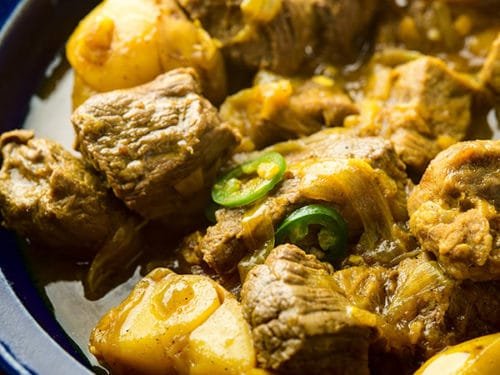
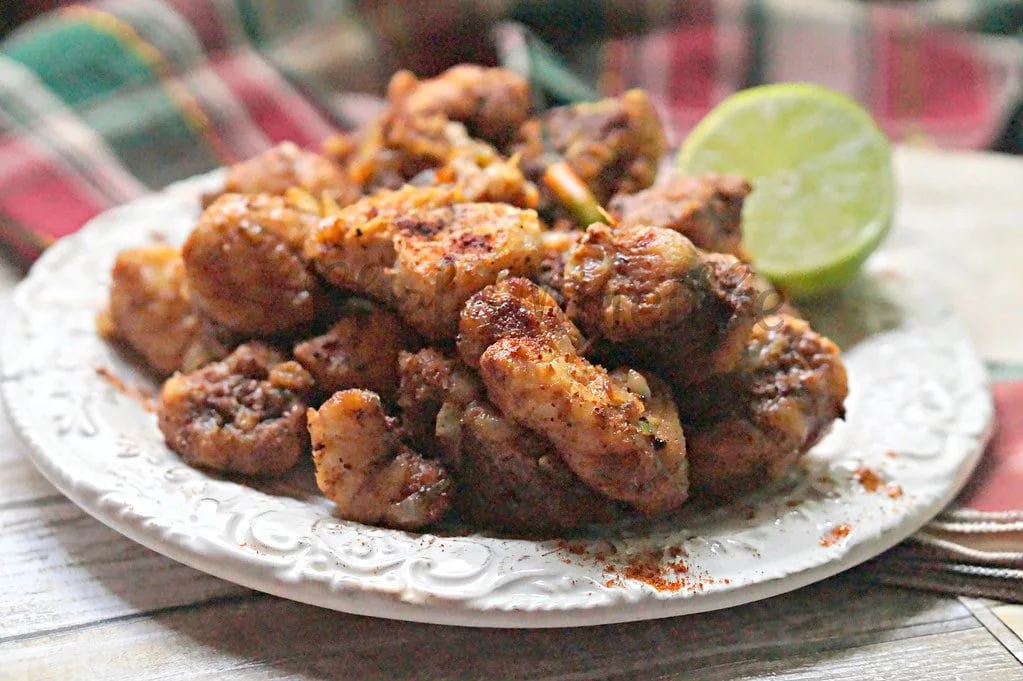
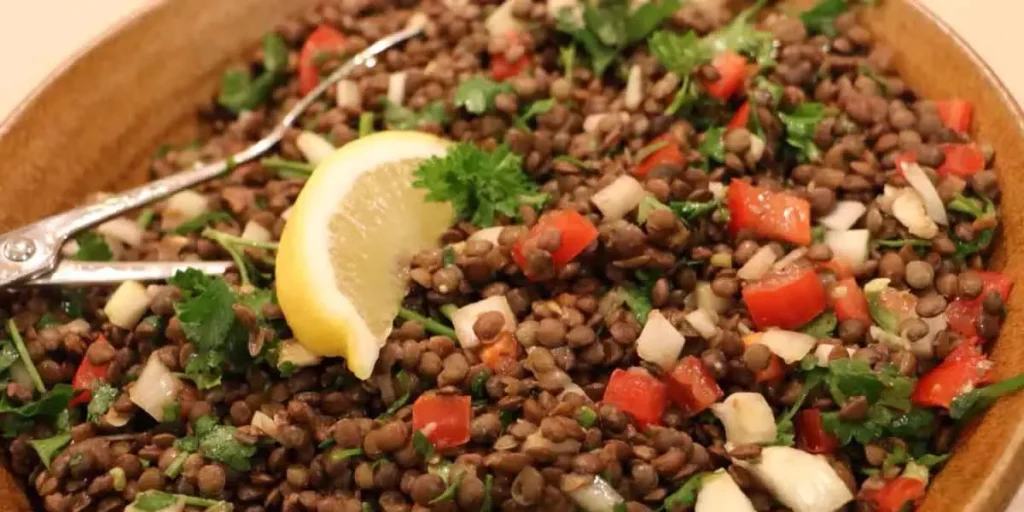
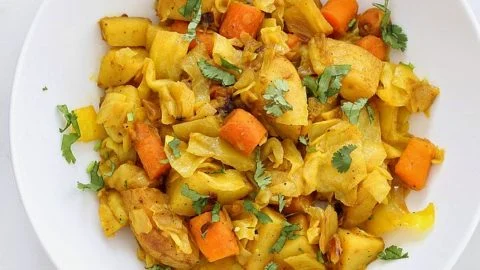
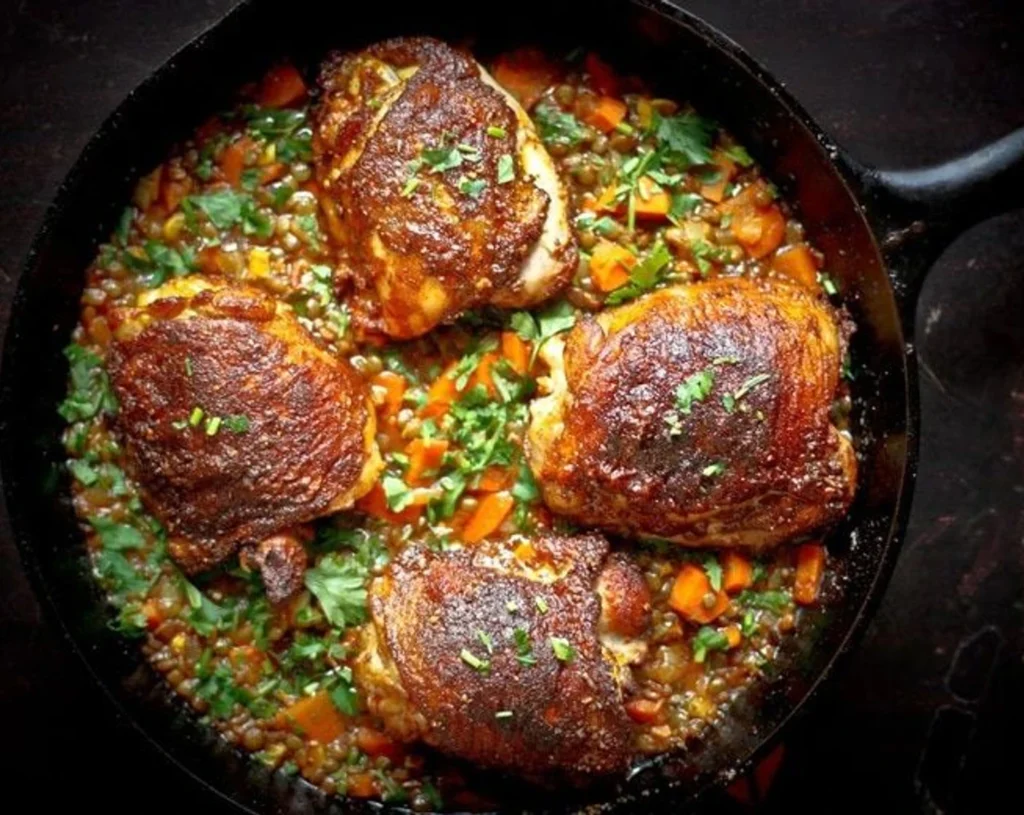

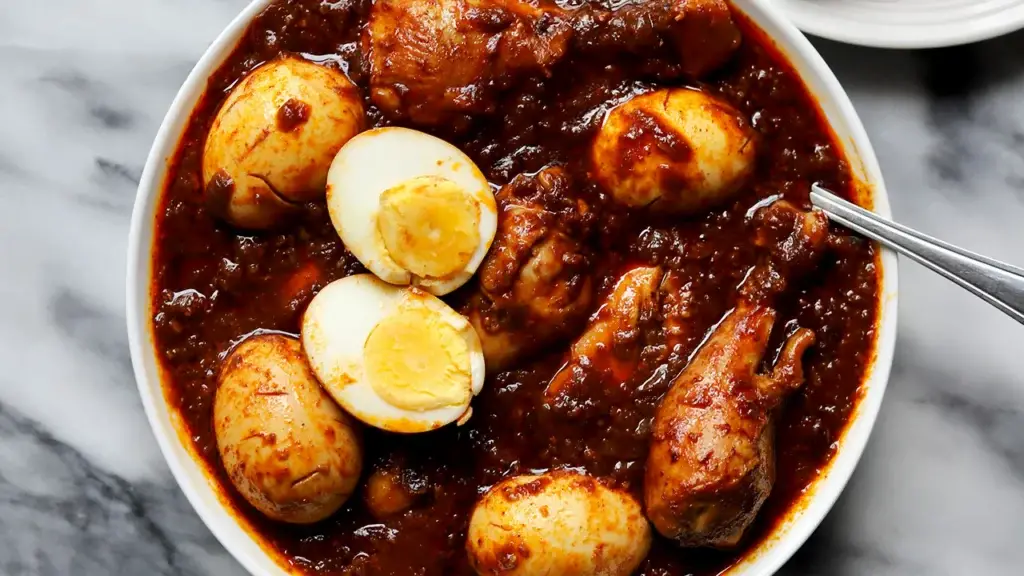
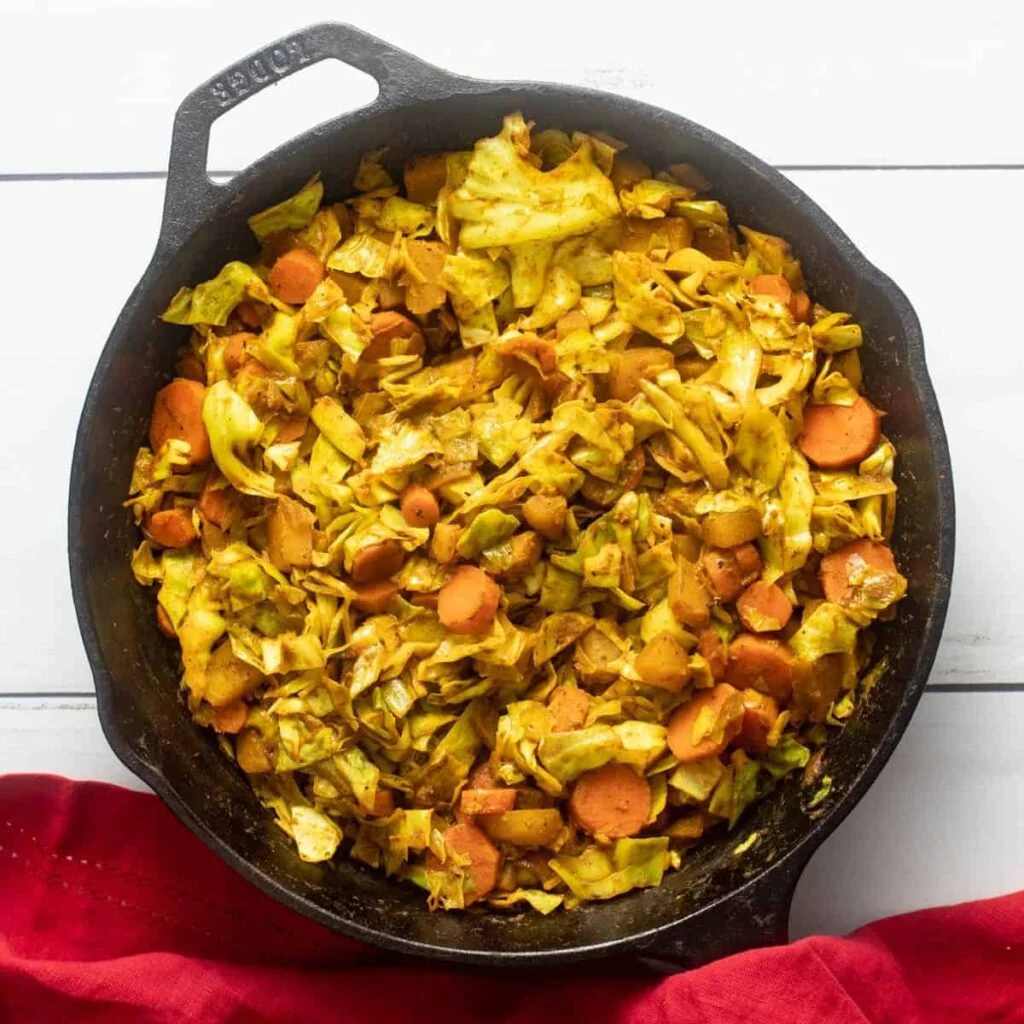


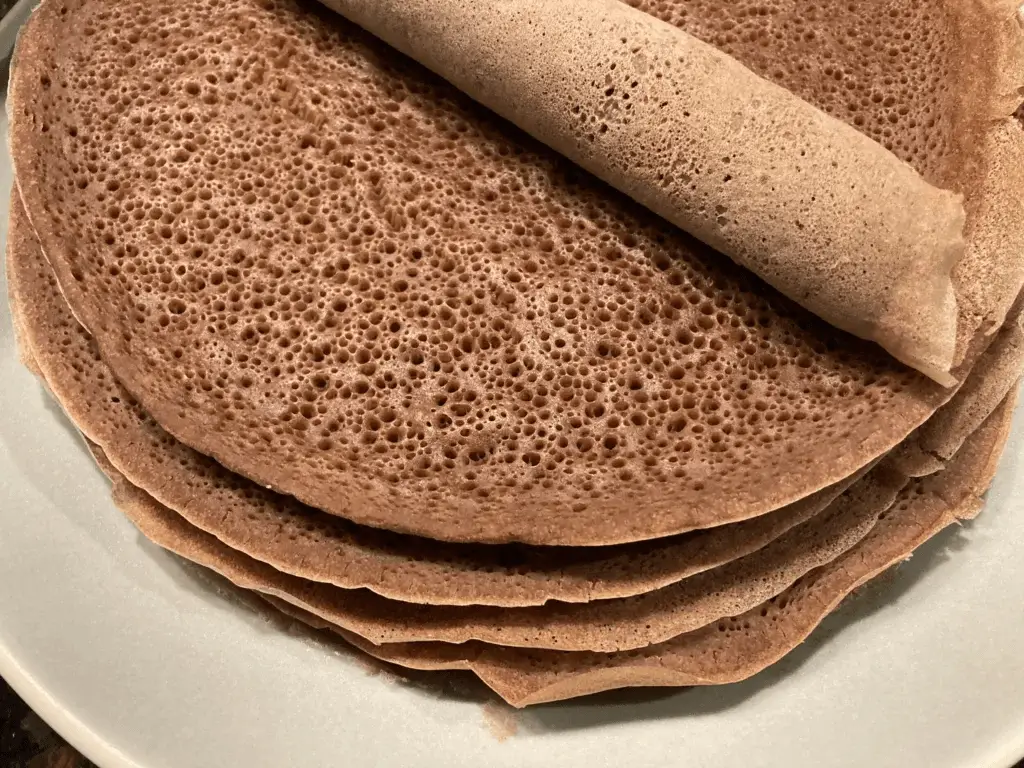

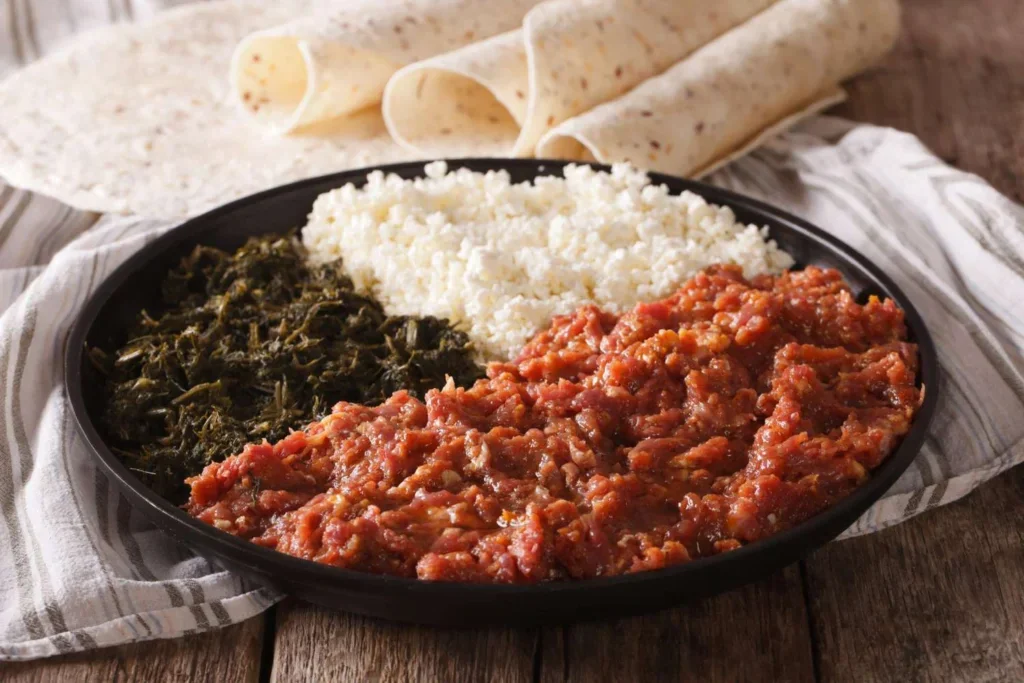
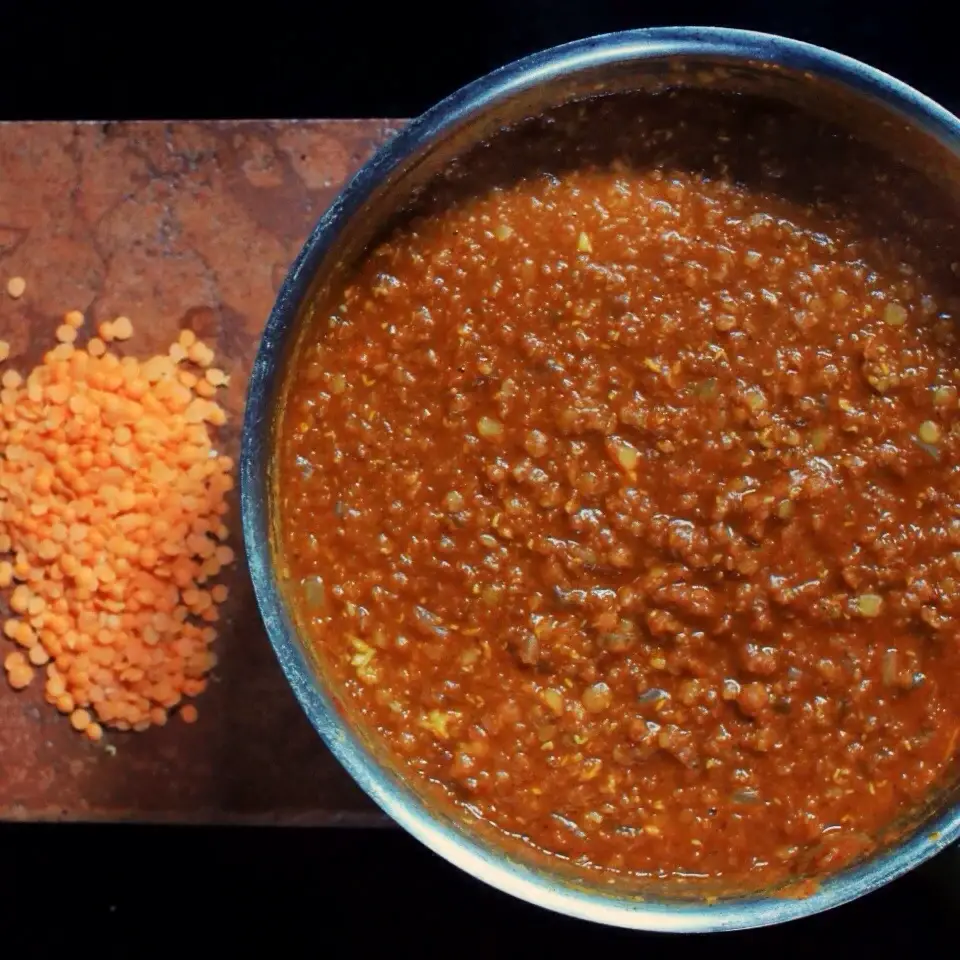

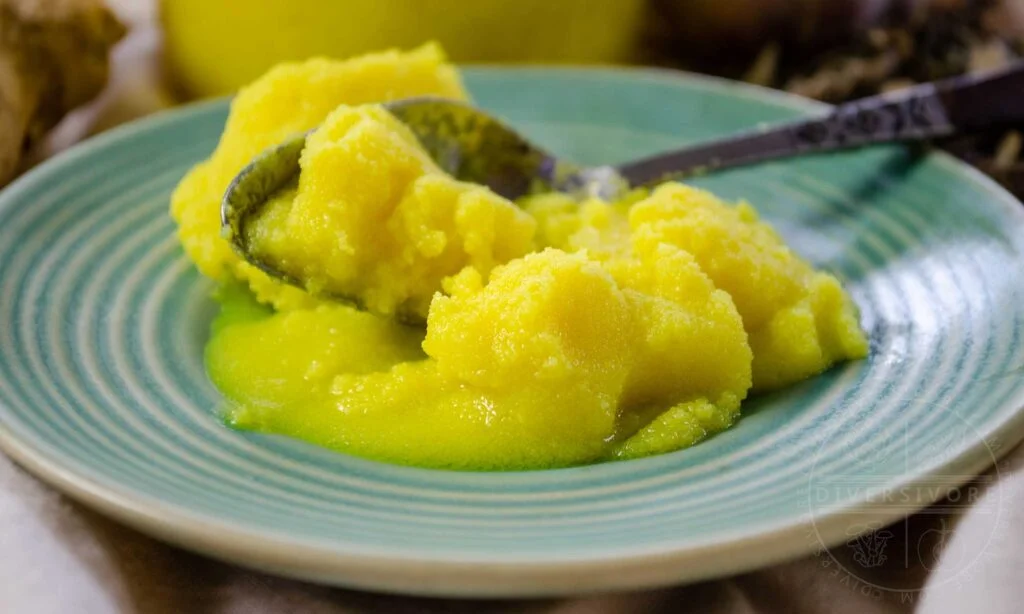
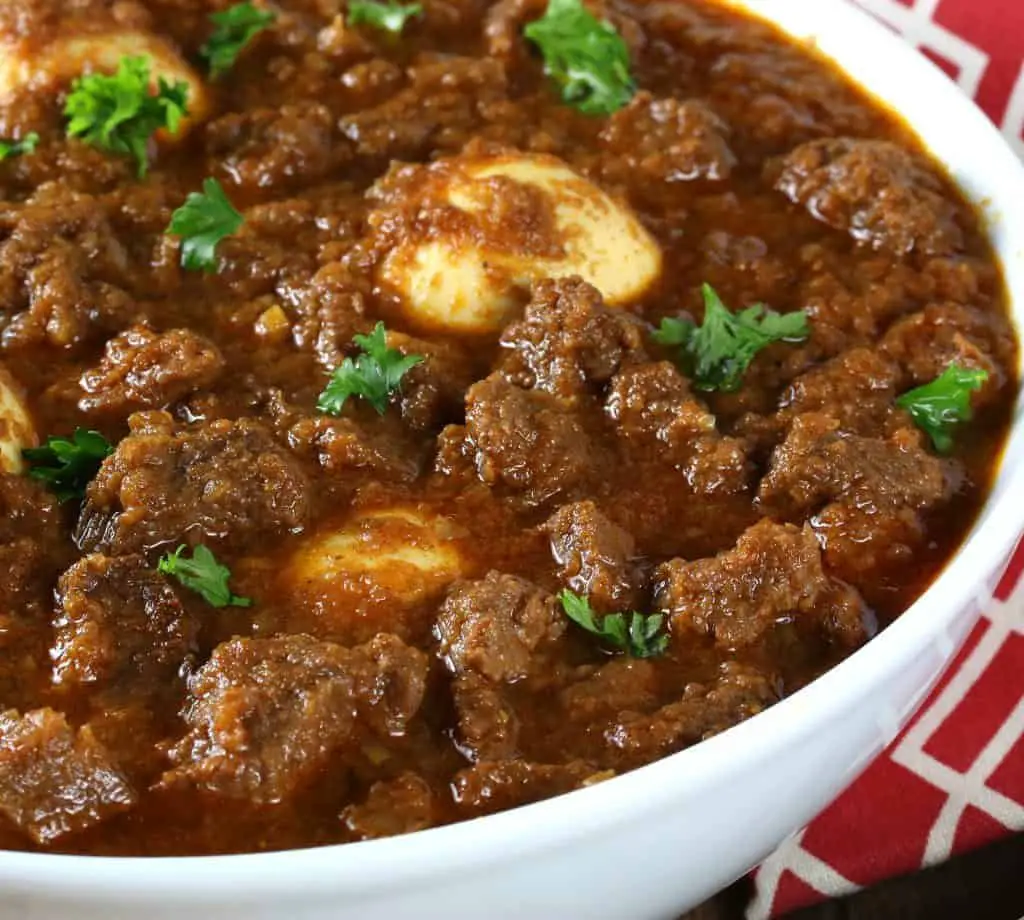
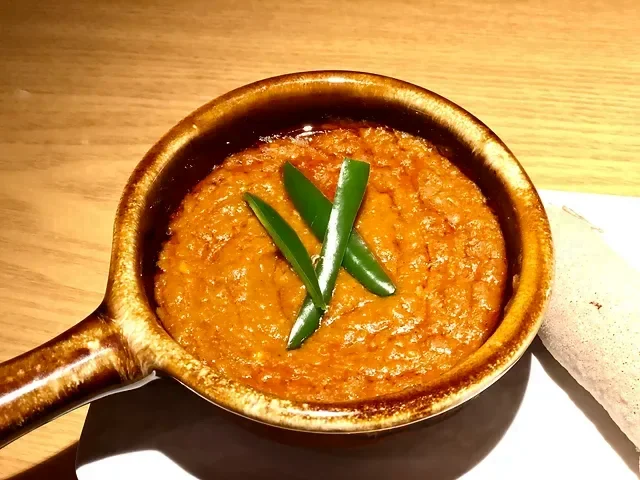
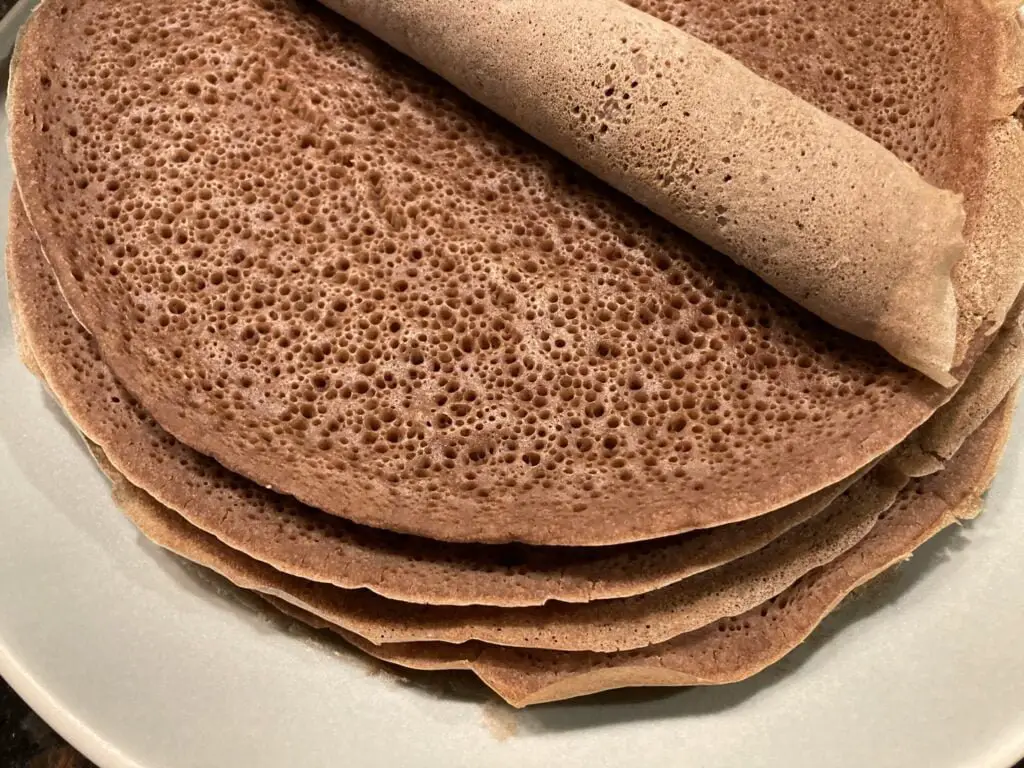

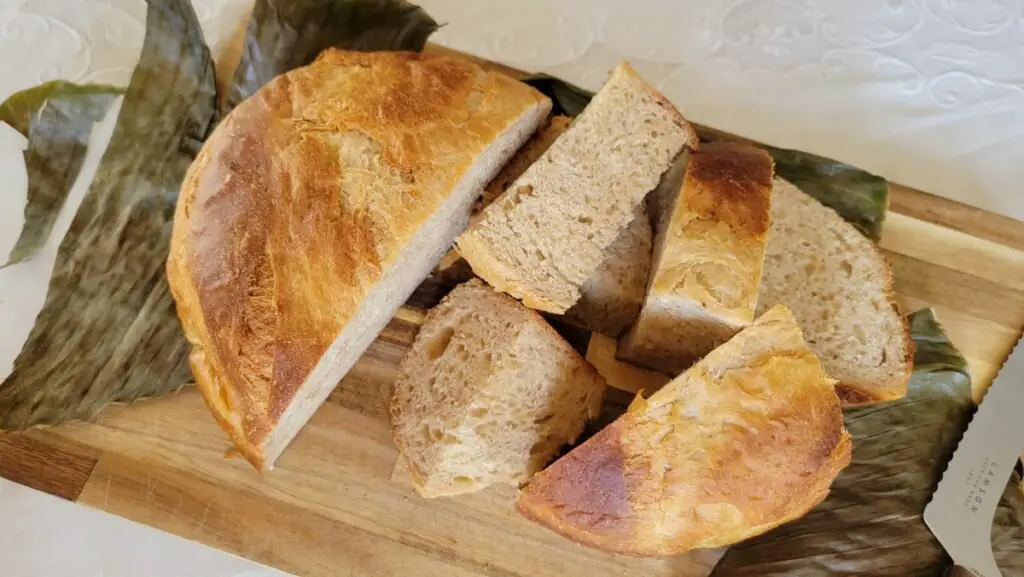
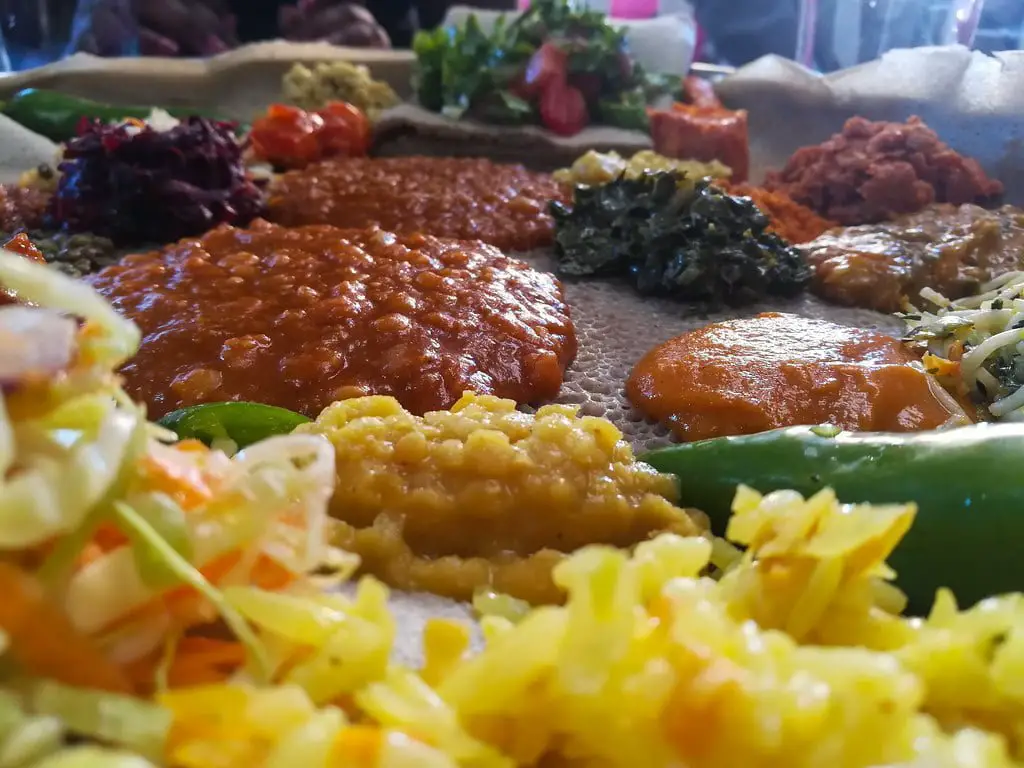
Interesting Facts About Ethiopia
Unique Calendar System

Ethiopia has its own calendar, known as the Ge’ez calendar, which is approximately 7–8 years behind the Gregorian calendar used by most of the world.
Land of Origins
Ethiopia is often referred to as the “Cradle of Humanity” as it is believed to be one of the earliest places where human ancestors lived.
Injera: A Staple Dish
Injera, a sourdough flatbread, is a staple in Ethiopian cuisine. It serves as both a utensil and an accompaniment to various dishes.
Lucy, the Famous Fossil

One of the most famous hominid fossils, Lucy, was discovered in Ethiopia in 1974. Lucy’s skeletal remains date back over 3 million years.
Unique Alphabet
Ethiopia has its own unique script, Ge’ez, which is one of the oldest alphabets still in use today.
Coffee’s Ethiopian Roots

Ethiopia is the birthplace of coffee. Legend has it that a goat herder discovered coffee beans after noticing his goats became more energetic after eating them.
The Only African Nation Never Colonized
Ethiopia is the only African country that was never colonized by European powers, maintaining its independence throughout the colonial era.
Lalibela’s Rock-Hewn Churches

Lalibela, a UNESCO World Heritage site, is home to 11 medieval rock-hewn churches carved out of solid rock in the 12th century.
Lake Tana and the Blue Nile
Lake Tana, the largest lake in Ethiopia, is the source of the Blue Nile, a major tributary of the Nile River.
Running Legends

Ethiopia has produced legendary long-distance runners, including Abebe Bikila, who won the Olympic marathon barefoot in 1960, and Haile Gebrselassie, a multiple world record holder.
The History of Ethiopia and how it has affected the Cuisine

Ethiopia, the cradle of humanity, boasts a rich and complex history reflected in its vibrant cuisine. Each era has left its unique mark, resulting in a diverse culinary tapestry that tantalizes the taste buds and tells a fascinating story. So, grab your virtual fork and join us as we trace the delicious evolution of Ethiopian cuisine through time:
Axumite Empire (4th Century BC – 7th Century AD)
- Spice Route Influence: Trade with India and the Middle East introduced spices like turmeric, cardamom, and cumin, laying the foundation for the signature spice blend berbere.
- Teff Cultivation: This indigenous grain, rich in nutrients and gluten-free, became the base for injera, the spongy flatbread that remains central to Ethiopian meals.
- Dietary Restrictions: Fasting due to religious beliefs led to the development of plant-based stews (wats) and the use of vegetable oils instead of animal fats.
Biblical Account (Acts 8:26-40)
Interestingly, the Acts of the Apostles mentions Philip encountering an Ethiopian eunuch on the road to Gaza. Some scholars believe this eunuch brought Christianity back to Ethiopia, which further influenced the cuisine with vegetarian practices for fasting periods.
Medieval Period (7th – 15th Century)
Rise of Christianity: Religious influence solidified the practice of fasting, leading to further diversification of vegetarian dishes using legumes, lentils, and vegetables.
Coffee Culture: Coffee beans arrived from Yemen, fostering a unique brewing tradition using a jebena pot and roasting rituals.
Gondarine Dynasty (16th – 18th Century)

Contact with Europe: Portuguese influence introduced new ingredients like chili peppers and tomatoes, adding a fiery touch to wats.
Royal Feasts: Grand banquets showcased culinary artistry, featuring elaborately decorated injera and diverse meat dishes.
19th & 20th Centuries
Italian Occupation: Briefly influenced the use of pasta and bread varieties.
Modernization: Urbanization and globalization introduced new ingredients and cooking methods, while traditional dishes remained central.
Present Day

Culinary Heritage Preserved: Traditional ingredients and cooking methods are cherished, with a growing appreciation for regional specialties.
Global Recognition: Ethiopian cuisine gains international popularity for its unique flavors and cultural significance.

So, the next time you savor a delicious Ethiopian wat or sip a fragrant cup of coffee, remember that you’re not just enjoying a meal – you’re experiencing a millennia-old culinary legacy shaped by diverse influences and a deep connection to history. Enjoy your exploration!
How the Geography and Climate has Affected Ethiopia Cuisine

Embark on a tantalizing journey through Ethiopia’s cuisine, where geography, climate, and history have woven a tapestry of unique flavors. From the sky-high plateaus to the fertile valleys, each region contributes its own distinct taste to the national table.
Land of Many Climates, Many Cuisines:
- Highland Haven: Imagine lush mountains cradling Ethiopia’s famed buna (coffee) and teff, the tiny grain transformed into the soul of Ethiopian meals – the spongy, tangy injera.
- Lowland Bounty: Descend to sun-drenched plains brimming with sorghum, millet, and enset (false banana), ingredients unique to these regions.
- Rift Valley Riches: Follow the Great Rift Valley, where fertile soil nurtures teff, barley, and legumes, while freshwater lakes teem with fish for delectable stews.
Seasons of Plenty and Challenge:
- Dancing with Droughts: Droughts paint the south and southeast, testing resilience, but rainy seasons in the highlands bless the land with life-giving water for precious teff.
- Coffee’s Cradle: Sip on aromatic buna, Ethiopia’s gift to the world. Highland mists nourish coffee beans, and the brewing ceremony remains a cherished cultural symbol.
Flavors that Define a Nation:
- Injera: The heart of every meal, this fermented teff flour flatbread absorbs stews with its spongy texture and tangy soul.
- Berbere’s Fiery Embrace: A symphony of flavors explodes with every bite – fiery chili peppers, fragrant garlic, ginger, and aromatic spices dance in this iconic blend.
- Niter Kibbeh’s Golden Touch: Clarified butter infused with spices lends depth and richness to Ethiopian dishes.
- Enset: Nature’s Lifeline: This “false banana” provides sustenance during droughts, its starchy core a testament to adaptability.
Beyond the Plate, a Cultural Feast:
- Sharing is Caring: Gather around a communal platter piled with injera, each guest picking up stews (wats) with their injera “utensil,” fostering connection and joy.
- Raw and Rare: Kitfo, a dish of minced raw beef, reflects Ethiopia’s pastoral heritage, a bold statement of trust in fresh, local ingredients.
References
- The United Nations World Food Programme (WFP) highlights the impact of conflict and climate shocks on food security in Ethiopia.
- WanderGlobe discusses how climate affects Indian cuisine, emphasizing the role of rivers and fertile soils.
- PLOS ONE explores the geography and similarity of regional cuisines in China, which also applies to Ethiopia.
- Springer examines climate change’s effects on food security in Ethiopia.
- Springer further discusses climate as a driver of food insecurity in Ethiopia.
Understanding the Essence of Ethiopian Cuisine
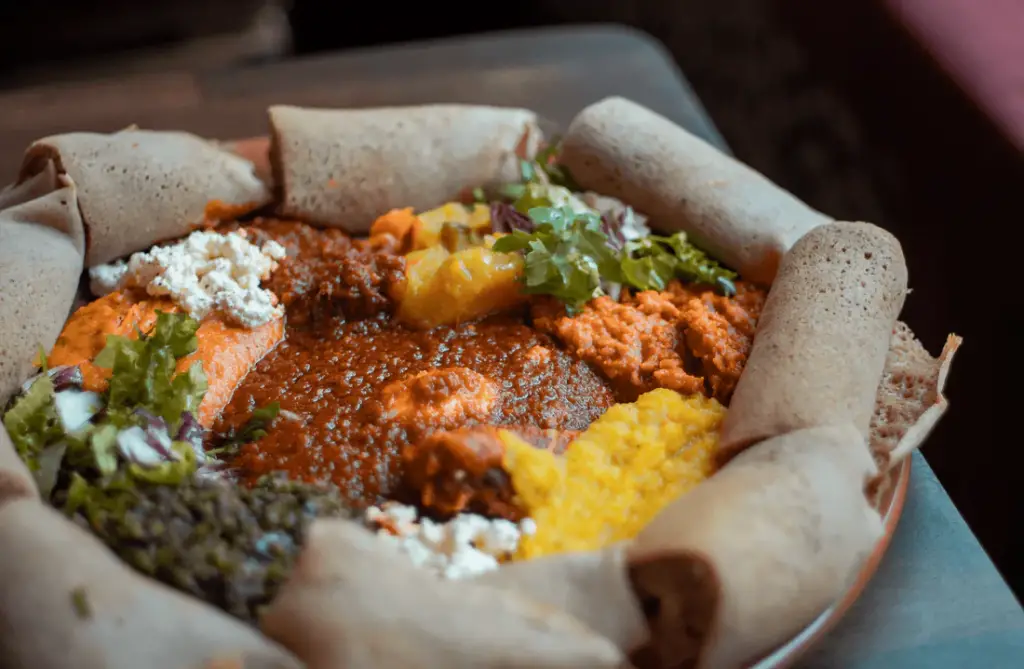
When it comes to Ethiopian cuisine, there are a few key elements that make it truly unique. Ethiopian food is bold with complex flavors, which come from a diverse range of spices and herbs. Chefs use these spices to create rich stews and curries, that they serve over injera, a sourdough flatbread that is a staple in Ethiopian cuisine.
One of the most distinctive aspects of Ethiopian cooking is the use of a spice blend called berbere. Berbere consists of a number of different herbs and spices, including chili peppers, ginger, and garlic.
Another popular spice blend is mitmita. Mitmita is has a spicy flavor and is ideal for meats and stews.
For those following a vegetarian or vegan diet, Ethiopian cuisine is a great choice. Many traditional Ethiopian dishes are naturally plant-based. There are a variety of delicious vegetarian stews and curries available. These dishes often feature lentils, chickpeas, and veggies like cabbage and carrots.
Whether you’re looking to spice up your cooking routine or just want to try something new and different, Ethiopian cuisine is definitely worth exploring. With its bold flavors, unique cooking methods, and emphasis on communal dining, it’s a culinary tradition that is sure to delight the senses.
Exploring Traditional Ethiopian Cuisine

When it comes to Ethiopian cuisine, traditional dishes are the heart and soul of the culture. From the spicy Doro Wat to the flavorful Tibs and Kitfo, Ethiopians of all ages enjoy these dishes. Each generation passes the recipes to the next and so they continue to be a staple in their daily diets.
One of the most iconic Ethiopian dishes is Doro Wat. This spicy chicken stew uses berbere, a fiery spice blend that gives that give it its distinctive flavor. Chefs usually serve Doro Wat with injera, a traditional sourdough flatbread, and is a popular choice for special occasions and celebrations.
Tibs is another favorite Ethiopian dish, consisting of grilled meat cooked with onions, garlic, and other spices.
Kitfo, on the other hand, is a minced raw meat dish that diners enjoy with injera and Ethiopian cottage cheese.
These dishes, and many others, are not only delicious but also offer insight into the cultural heritage of Ethiopians. Traditionally they share he dishes with family and friends, highlighting the importance of community and togetherness in Ethiopian culture.
Enjoying Ethiopian National Dishes
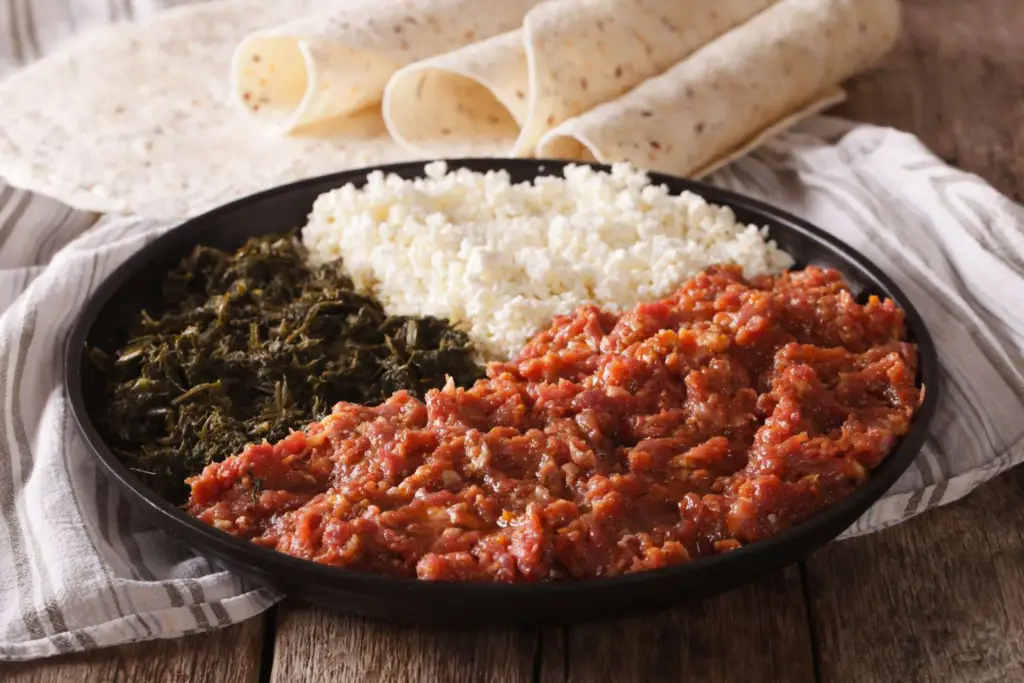
While traditional dishes vary from region to region in Ethiopia, there are a few national dishes that are everyone enjoys throughout the country. One of these is Kifto, a dish made with minced raw beef mixed with spices and served with injera.
Another popular national dish is Kitfo, which is similar to Kifto but chefs prepare by cooking instead of being served raw.
Ethiopian cuisine also features a variety of vegetarian dishes, such as Shiro, a flavorful stew made with ground chickpeas or lentils, and Misir Wat, a spicy lentil stew that is a favorite among vegetarians.
Whether you’re a meat lover or a vegetarian, there is something for everyone in Ethiopian cuisine. These dishes offer a glimpse into the history and culture of Ethiopia and are a must-try for anyone looking to explore the vibrant world of Ethiopian cuisine.
Unveiling the Secrets of Ethiopian Spices
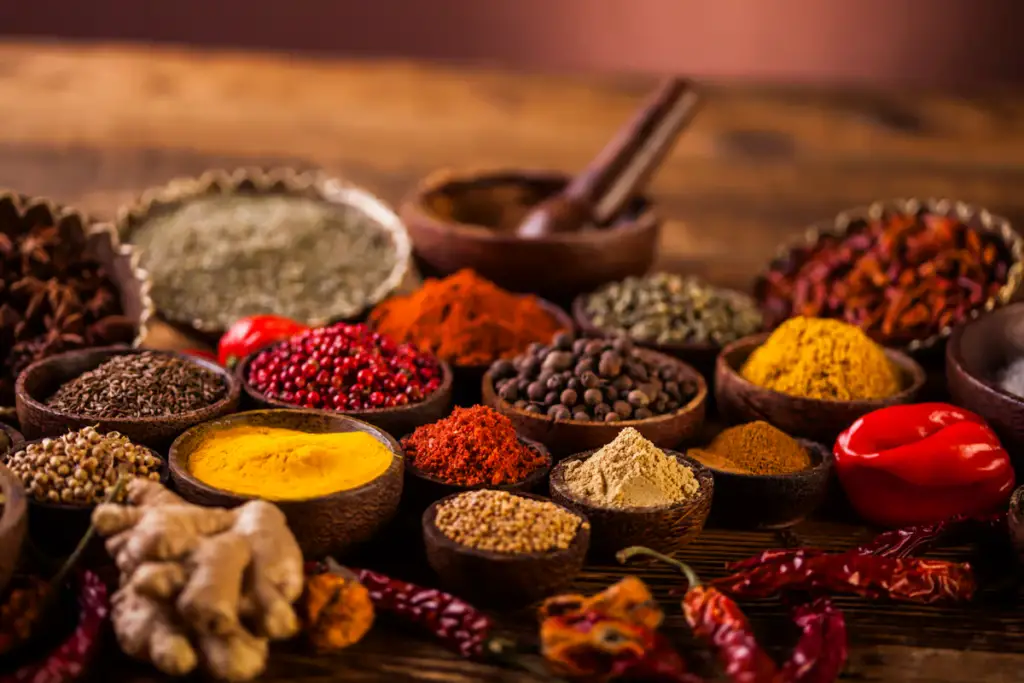
When it comes to Ethiopian cuisine, spices play a critical role in defining the unique flavors and aromas of the dishes.
Ethiopian spices have bold and complex flavors. A combination of various herbs, seeds, and spices achieve this.
One of the most popular Ethiopian spice blends is berbere. Chefs use this fiery mix of chili peppers, garlic, ginger, shallots, and other spices in stews and sauces to add heat and depth of flavor.
Mitmita is another spice blend that is that appears in Ethiopian cooking. It typically contains a mix of chilies, cardamom, cloves, and other spices, and has a smoky, spicy flavor.
Other commonly used spices in Ethiopian cuisine include cumin, coriander, turmeric, and cinnamon. Chefs often use these spices in conjunction with one another to create unique blends that complement the flavors of various dishes.
What sets Ethiopian spices apart from others is their preparation. Traditionally the craftsmen roast and grind the spices by hand, which enhances their flavors and aromas.
They then cook the spices n oil or butter to release their flavors and help them blend with other ingredients.
When preparing Ethiopian dishes at home, it is essential to source high-quality spices to achieve authentic flavors. Look for specialty stores that carry Ethiopian spices or purchase them online from reputable sources.
Now that you know more about Ethiopian spices, experiment with different blends to unlock the full potential of Ethiopian cuisine in your own kitchen!
Ethiopian Cooking Methods

Ethiopian cooking methods vary regionally, but a common technique is the use of a traditional clay cooking vessel called a “mitad.” This round, flat griddle is heated from below and cooks injera, a staple Ethiopian bread.
Other popular methods include stewing, grilling, and frying, all using aromatic spices like berbere and niter kibbeh for flavor.
Mastering Vegetarian Ethiopian Cuisine Recipes

If you’re looking for delicious plant-based options, Ethiopian cuisine has plenty to offer. From lentil stews to vegetable curries, there are many vegetarian dishes that highlight the unique spices and flavors of Ethiopian cooking.
One of the most popular vegetarian dishes is Shiro, a spicy stew made from ground chickpeas or lentils. Another favorite is Gomen, a stew made from collard greens and served with injera. And for a burst of flavor, try Misir Wot, a spicy lentil stew made with berbere spice.
Creating these dishes requires a combination of spices, such as cumin, turmeric, and paprika, along with fresh ingredients like tomatoes and onions. And, of course, you can’t forget the injera, which serves as the perfect accompaniment to these dishes.
But don’t worry if you’re new to Ethiopian cooking – there are plenty of resources available to help you master these vegetarian recipes. Plus, with so many flavorful options to choose from, you’re sure to find a dish that you and your family will love.
Understanding the Significance of Injera
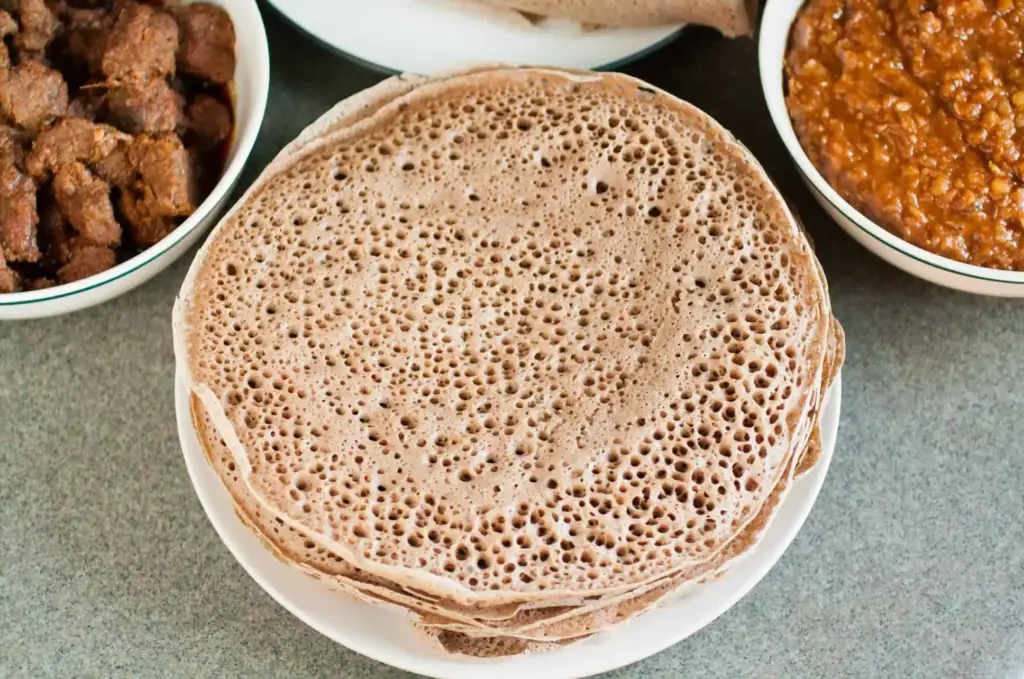
If you’re looking to experience Ethiopian cuisine, injera is a staple that you can’t miss. This sourdough flatbread is an essential part of Ethiopian traditional cuisine. Chefs often serve Injera as a base for various dishes, where they place them on top of the bread and scooped up with pieces of injera.
The process of making injera is an art form, and it involves fermenting teff flour batter over several days. Teff is a tiny grain that is native to Ethiopia, and it’s rich in nutrients like iron and fiber. The batter is left to ferment, which gives the bread its signature sour taste.
When you’re in Ethiopia, you’ll notice that injera arrives with almost every meal. It’s a versatile bread that chefs can serve with meat, vegetables, and legumes. And the best part? Injera is gluten-free, making it a great option for people who are sensitive to gluten.
To make injera at home, you’ll need teff flour, water, and a bit of patience. Mix the ingredients together to form a batter and let it sit for a few days until it ferments. The chef will pour the batter onto a hot griddle and cook it until the edges start to curl and the top is set.
It may take a few tries to perfect your injera-making skills, but once you do, you’ll have an authentic taste of Ethiopian cuisine right in your own home.
Experiencing the Ethiopian Coffee Ceremony

One of the most unique and memorable experiences in Ethiopian cuisine is the traditional coffee ceremony. The ceremony is a symbol of hospitality and respect.
Hosts often use it to welcome guests or to mark important occasions.
The ceremony typically begins with roasting the coffee beans over an open flame, filling the air with a rich, smoky aroma. They grind the beans by hand and brew the coffee in a traditional clay pot called a jebena.
Once the coffee is ready, they pour it into small cups and serve it with sugar or salt and a variety of snacks such as popcorn or peanuts.
The coffee ceremony is a social event, allowing people to come together and share stories and laughter over a warm cup of coffee. It’s not uncommon for the ceremony to last for hours, with guests enjoying multiple cups of coffee and relishing in the company of their loved ones.
If you want to experience the Ethiopian coffee ceremony yourself, all you need is a jebena, a handful of coffee beans, and some friends to share it with. Take your time, enjoy the process, and savor the rich, bold flavors of Ethiopian coffee.
Embracing Ethiopian Culinary Traditions
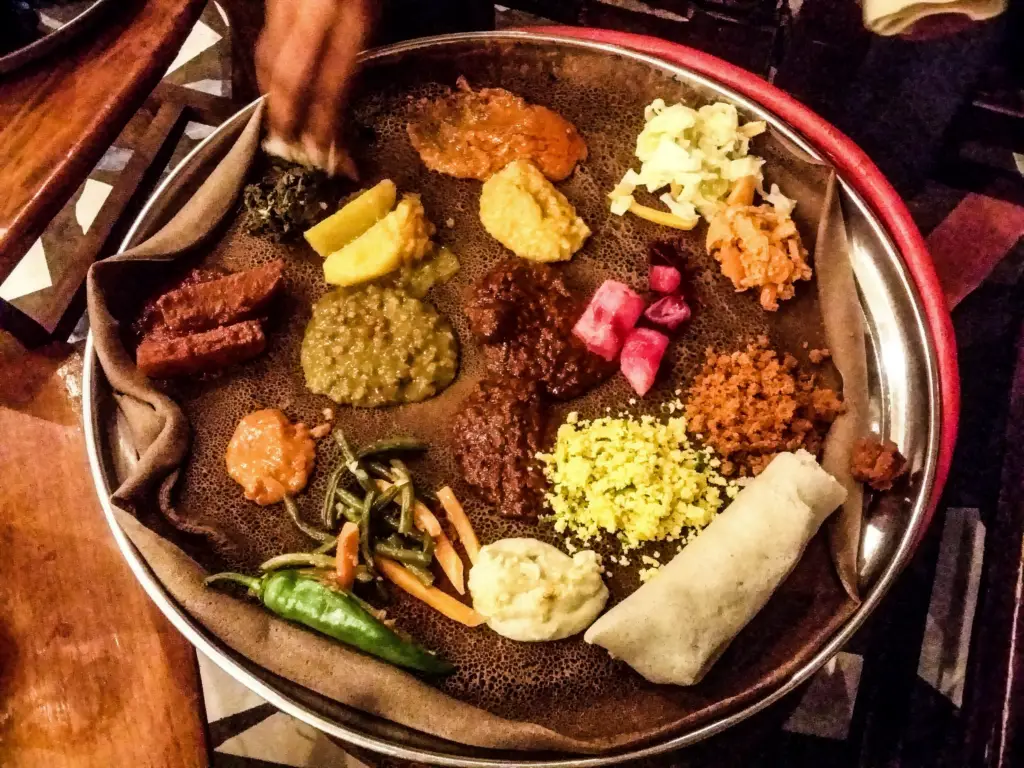
As I delved deeper into the world of Ethiopian cuisine and recipes, I discovered that it is not just about the food, but also about the cultural traditions and customs that surround it. In Ethiopia, food is more than just sustenance; it’s a way of bringing people together, fostering community, and celebrating life.
Ethiopian traditional cuisine is steeped in centuries-old culinary traditions that have been passed down from generation to generation. From the iconic Doro Wat, a spicy chicken stew considered the national dish of Ethiopia, to Tibs, a grilled meat dish, Ethiopian national dishes are an important part of the nation’s cultural identity.
What I found particularly fascinating about Ethiopian cuisine is the extent to which they share it communally. Ethiopians often eat together from a large communal plate, using injera, a sourdough flatbread, to scoop up the food. This act of sharing food is a symbol of unity and togetherness, and it’s a deep tradition in Ethiopian culture.
Moreover, certain Ethiopian national dishes associate with specific celebrations and gatherings. For example, they serve Doro Wat on holidays and at special events like weddings.
They serve Kitfo, a minced raw meat dish, during Ethiopian New Year celebrations. These dishes are not just about the food; they are about coming together to celebrate and honor important occasions.
By exploring Ethiopian culinary traditions, you can gain a deeper appreciation for the cultural significance of Ethiopian cuisine and the role it plays in Ethiopian society. Whether you’re enjoying a traditional meal with friends and family or trying out a new Ethiopian recipe at home, you’re participating in a rich and dynamic culinary tradition that has endured for centuries.
Popular Ethiopean Dishes
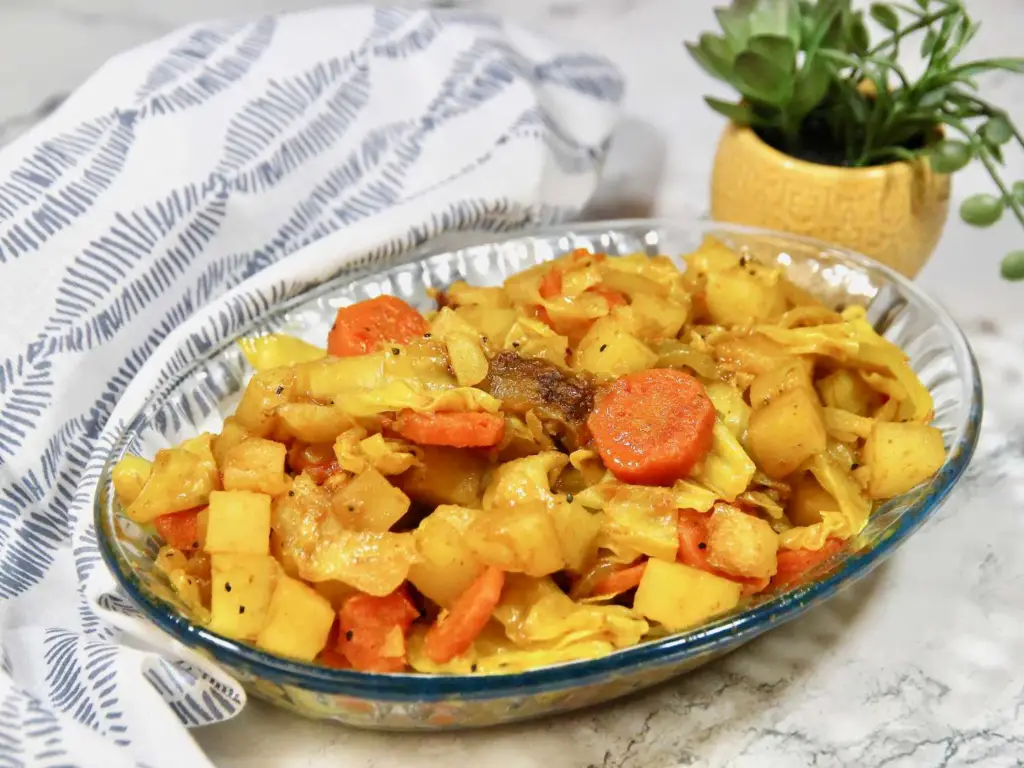
The most popular Ethiopean dishes are listed below.
- Doro Wat: Spicy chicken stew delight.
- Injera: Tangy, sourdough flatbread foundation.
- Kitfo: Minced raw meat perfection.
- Tibs: Grilled or sautéed meat.
- Shiro: Savory chickpea or lentil paste.
- Atakilt Wat: Mixed vegetable stew goodness.
- Berbere Chicken: Flavorful spice-infused roasted chicken.
- Teff Injera: Gluten-free, nutrient-rich flatbread staple.
- Misir Wat: Rich, spicy red lentils.
- Kitfo Leb Leb: Warmed, spiced minced meat.
How Healthy is Ethiopian Food?

Ethiopian cuisine is a delightful fusion of flavors, textures, and traditions. Let’s explore its health aspects and how they impact the population:
Vegetarian and Vegan Options
Many Ethiopian dishes are vegetarian or vegan due to religious fasting practices. These plant-based meals incorporate a variety of vegetables, fruits, whole grains, and minimally processed foods.
Consuming a balanced diet rich in plant-based ingredients can have several health benefits, including improving lifespan, lowering the risk of coronary disease, high blood pressure, and diabetes.
High Fiber Content
Teff, a tiny grain, is the star of Ethiopian cuisine. It’s used to make the iconic sourdough flatbread called injera.
Teff and other grains in Ethiopian dishes are high in fiber. Fiber:
- Regulates digestion and prevents constipation.
- Lowers cholesterol levels and promotes heart health.
- Helps control blood sugar levels and reduces inflammation.
Herbs and Spices
Ethiopian cuisine generously uses herbs and spices like turmeric, garlic, ginger, and basil.
These ingredients offer health benefits, such as anti-inflammatory properties and aiding digestion.
Global Influence
Authentic Ethiopian food has gained popularity worldwide. From roadside stalls in Bangkok to high-end restaurants in New York, people from diverse backgrounds are embracing it.
The influence of Ethiopian cuisine on global food culture is dynamic and exciting3.
In summary, Ethiopian cuisine’s emphasis on plant-based ingredients, fiber-rich grains, and flavorful spices contributes to its overall healthiness. So, let’s celebrate injera, berbere, and the vibrant streets of Addis Ababa! 🇪🇹🥘🌿.
References
Bringing Ethiopian Cuisine Flavors to Your Kitchen
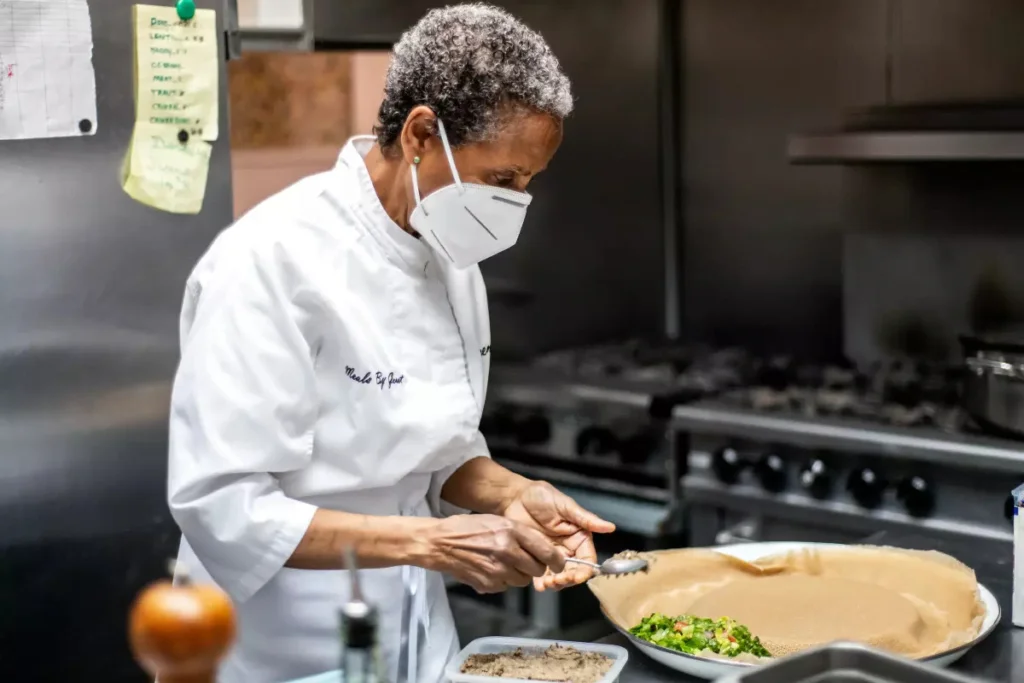
If you’re ready to take your taste buds on a journey to Ethiopia, it’s time to get cooking! With a few essential ingredients and some simple steps, you can recreate the vibrant flavors of Ethiopian cuisine in your own kitchen.
Start by stocking up on spices like berbere and mitmita, which are essential to many Ethiopian dishes. You can find these spices at specialty stores or online. Don’t forget to pick up some lentils, vegetables, and meat, depending on your dietary preferences.
One of the most important components of Ethiopian cuisine is injera, the sourdough flatbread. While making injera from scratch can be a bit tricky, there are ready-made varieties available at many stores. If you’re feeling up to the challenge, there are also plenty of recipes available online to try your hand at making injera at home.
Ethiopian Cuisine – Cooking Techniques
When it comes to cooking Ethiopian dishes, there are a few key techniques to keep in mind. Many dishes are simmer slowly over low heat, allowing the flavors to meld together and develop.
With others they grill or sauté them to create a crispy texture. As always, be sure to taste as you go and adjust seasonings as needed.
Don’t be afraid to experiment with different recipes and flavor combinations. Ethiopian cuisine is incredibly versatile and there are countless ways to customize dishes to your liking.
Whether you’re in the mood for a spicy meat stew or a flavorful vegetarian curry, there’s a recipe out there for you.
So why not try your hand at creating some delicious Ethiopian dishes in your own kitchen? With a little bit of patience and a lot of flavors, you’re sure to impress your taste buds and your dinner guests.
Are you ready to try your hand at Ethiopian cooking? With a few key ingredients and some simple techniques, you can bring the authentic taste of Ethiopia into your own kitchen. Here are some tips to get you started:
Ethiopian Food – Atakilt Wat (Mixed Vegetable Stew Goodness)

Unveiling Ethiopia’s Culinary Tapestry: Atakilt Wat (Mixed Vegetable Stew Goodness)
In the heart of Ethiopia, a land with a rich tapestry of flavors and traditions, we explore Atakilt Wat—a delectable mixed vegetable stew that embodies the country’s vibrant culinary heritage.
Rooted in Ethiopia’s diverse agriculture and spice trade, Atakilt Wat is a celebration of colorful vegetables harmoniously cooked to perfection. Let’s delve into the history and savor the goodness of this traditional Ethiopian dish.
Ethiopian Food – Atakilt Wat Ingredients:
- 2 potatoes, peeled and cubed
- 2 carrots, peeled and sliced
- 1 cabbage, shredded
- 1 onion, finely chopped
- 3 tomatoes, diced
- 3 cloves garlic, minced
- 2 tablespoons vegetable oil
- 1 teaspoon ginger, grated
- 1 teaspoon turmeric
- 1 teaspoon cumin
- 1 teaspoon paprika
- Salt and pepper to taste
- Fresh cilantro for garnish
Ethiopian Food – Atakilt Wat Recipe:
1. Prepare Vegetables:
- Peel and cube the potatoes.
- Peel and slice the carrots.
- Shred the cabbage.
- Finely chop the onion.
- Dice the tomatoes.
2. Sauté Aromatics:
- In a large pot, heat vegetable oil over medium heat.
- Add chopped onion, minced garlic, and grated ginger. Sauté until fragrant.
3. Add Spices:
- Sprinkle turmeric, cumin, paprika, salt, and pepper into the pot. Stir well to coat the aromatics with the spices.
4. Incorporate Vegetables:
- Add the prepared potatoes, carrots, and cabbage to the pot, stirring to combine.
- Pour in diced tomatoes, ensuring they are well integrated into the mixture.
5. Simmer:
- Cover the pot and let Atakilt Wat simmer over low to medium heat for 20-25 minutes, or until the vegetables are tender but not mushy.
6. Garnish and Serve:
- Once cooked, garnish the stew with fresh cilantro.
- Serve hot, either as a standalone dish or paired with injera, the traditional Ethiopian flatbread.
Serving Size:
- This recipe serves 4 people.
Estimated Cooking Time:
- 30 minutes.
Nutritional Information (Per Serving):
- Calories: 180
- Protein: 4g
- Fat: 7g
- Carbohydrates: 25g
- Fiber: 6g
Indulge in the goodness of Ethiopia with Atakilt Wat—a delightful mixed vegetable stew that reflects the country’s commitment to fresh, flavorful ingredients. This dish not only satisfies the taste buds but also showcases the vibrant colors and culinary diversity of Ethiopian cuisine.
Ethiopian Food – Berbere Chicken (Flavorful Spice-Infused Roasted Chicken)

Exploring Ethiopia’s Culinary Gem: Berbere Chicken (Flavorful Spice-Infused Roasted Chicken)
In the heart of Ethiopia’s culinary landscape, we dive into the depths of Berbere Chicken—a dish that encapsulates the country’s love for bold spices and rich flavors. Hailing from the historic and diverse Ethiopian gastronomy, Berbere Chicken combines the warmth of local spices with succulent roasted chicken, creating a truly unforgettable experience.
Let’s unravel the history and savor the aromatic journey of this delightful Ethiopian classic.
Ethiopian Food – Berbere Chicken Ingredients:
- 2 pounds chicken pieces
- 2 tablespoons Berbere spice blend
- 2 tablespoons olive oil
- 1 teaspoon ground ginger
- 1 teaspoon garlic powder
- 1 teaspoon paprika
- Salt and pepper to taste
- 1 lemon, sliced
- Fresh cilantro for garnish
Ethiopian Food – Berbere Chicken Recipe:
1. Marinate the Chicken:
- In a bowl, mix Berbere spice blend, olive oil, ground ginger, garlic powder, paprika, salt, and pepper to form a paste.
- Coat the chicken pieces with the spice paste, ensuring an even distribution.
2. Let It Marinate:
- Cover the bowl and let the chicken marinate in the refrigerator for at least 2 hours, allowing the flavors to meld.
3. Preheat the Oven:
- Preheat your oven to 375°F (190°C).
4. Arrange the Chicken:
- Place the marinated chicken pieces in a roasting pan or on a baking sheet.
5. Add Lemon Slices:
- Scatter lemon slices over the chicken for an extra burst of citrus flavor.
6. Roast in the Oven:
- Roast the Berbere Chicken in the preheated oven for 40-45 minutes or until the chicken reaches an internal temperature of 165°F (74°C).
7. Garnish and Serve:
- Once roasted, garnish the chicken with fresh cilantro.
- Serve hot, either on its own or paired with injera, the traditional Ethiopian flatbread.
Serving Size:
- This recipe serves 4 people.
Estimated Cooking Time:
- 45 minutes.
Nutritional Information (Per Serving):
- Calories: 300
- Protein: 25g
- Fat: 18g
- Carbohydrates: 5g
- Fiber: 1g
Embark on a flavorful journey with Berbere Chicken—an embodiment of Ethiopia’s spice-laden culinary traditions. Roasted to perfection, this dish invites you to experience the warmth and depth of Ethiopian cuisine in the comfort of your own home.
Ethiopian Food – Teff Injera (Gluten-Free, Nutrient-Rich Flatbread Staple)

Unveiling Ethiopia’s Nutrient-Rich Gem: Teff Injera (Gluten-Free Flatbread Staple)
Embark on a journey through the culinary heart of Ethiopia with Teff Injera—a gluten-free flatbread that stands as a staple in the country’s vibrant cuisine. Teff, a tiny grain native to Ethiopia, takes center stage in this traditional dish, providing not only a unique flavor but also a wealth of nutrients.
Join me as we explore the history and dive into the simplicity and nutritional richness of Teff Injera, a cornerstone of Ethiopian dining.
Ethiopian Food – Teff Injera Ingredients:
- 2 cups teff flour (mixed colors for variety)
- 3 cups water
- 1/2 teaspoon salt
Ethiopian Food – Teff Injera Recipe:
1. Prepare the Batter:
- In a large mixing bowl, combine teff flour, water, and salt.
- Stir well to create a smooth, lump-free batter.
2. Ferment the Batter:
- Cover the bowl with a cloth and let the batter ferment at room temperature for 24-48 hours. This natural fermentation process adds depth to the flavor.
3. Heat the Griddle:
- Once fermented, the batter will have a bubbly appearance. Stir it well.
- Heat a non-stick griddle or skillet over medium heat.
4. Ladle and Cook:
- Using a ladle, pour a small amount of batter onto the hot griddle, swirling it around to spread thinly.
- Cook for 1-2 minutes until the edges lift and the injera can be easily peeled from the griddle.
5. Stack and Serve:
- Repeat the process until all the batter is used, stacking the injera as they are cooked.
- Serve the Teff Injera warm with your favorite Ethiopian dishes.
Serving Size:
- This recipe makes approximately 10 injera.
Estimated Cooking Time:
- 24-48 hours for fermentation, 20-30 minutes for cooking.
Nutritional Information (Per Serving – One Injera):
- Calories: 70
- Protein: 2g
- Fat: 0.5g
- Carbohydrates: 15g
- Fiber: 2g
Experience the gluten-free goodness of Ethiopia with Teff Injera. Its earthy flavor, combined with the health benefits of teff, makes it a versatile and nutritious addition to any meal. Make your dining experience truly Ethiopian by incorporating this delightful flatbread into your culinary repertoire.
Ethiopian Food – Ethiopian Pomegranate Rice Pilaf

Unraveling Flavors: Ethiopian Pomegranate Rice Pilaf
Step into the vibrant culinary tapestry of Ethiopia as we explore the intriguing Ethiopian Pomegranate Rice Pilaf. Rooted in the country’s rich history and the bold use of spices, this dish brings together the nutty aroma of rice, the sweetness of pomegranate, and a symphony of Ethiopian flavors.
Join me on this culinary adventure, celebrating the unique combination of ingredients that make Ethiopian Pomegranate Rice Pilaf a true gem.
Ethiopian Food – Ethiopian Pomegranate Rice Pilaf Ingredients:
- 2 cups basmati rice
- 4 cups vegetable broth
- 1 cup pomegranate seeds
- 1 onion, finely chopped
- 2 tablespoons olive oil
- 1 teaspoon cumin
- 1 teaspoon cinnamon
- Salt and pepper to taste
- Fresh parsley for garnish
Ethiopian Food – Ethiopian Pomegranate Rice Pilaf Recipe:
1. Rinse and Soak Rice:
- Rinse the basmati rice under cold water until the water runs clear.
- Soak the rice in water for 30 minutes, then drain.
2. Sauté Aromatics:
- In a large pot, heat olive oil over medium heat.
- Add finely chopped onion and sauté until translucent.
3. Add Spices:
- Stir in cumin and cinnamon, allowing the spices to infuse into the onions.
4. Cook Rice:
- Add the soaked and drained rice to the pot, stirring to coat the grains in the aromatic mixture.
- Pour in vegetable broth, salt, and pepper. Bring to a boil.
5. Simmer and Fluff:
- Reduce heat to low, cover the pot, and let the rice simmer for 15-20 minutes or until fully cooked.
- Once cooked, fluff the rice with a fork to separate the grains.
6. Incorporate Pomegranate Seeds:
- Gently fold in the fresh pomegranate seeds, allowing them to mix evenly with the rice.
7. Garnish and Serve:
- Garnish the Ethiopian Pomegranate Rice Pilaf with fresh parsley.
- Serve warm as a delightful side dish.
Serving Size:
- This recipe serves 6 people.
Estimated Cooking Time:
- 45 minutes.
Nutritional Information (Per Serving):
- Calories: 230
- Protein: 4g
- Fat: 5g
- Carbohydrates: 44g
- Fiber: 2g
Indulge in the exquisite flavors of Ethiopia with this Pomegranate Rice Pilaf. Its unique blend of spices, nutty rice, and bursts of pomegranate seeds create a culinary masterpiece that transports you to the heart of Ethiopian dining.
Ethiopian Food – Ethiopian Asa Tibs (Fried Fish)

A Culinary Adventure: Ethiopian Asa Tibs (Fried Fish)
Embark on a culinary journey through the vibrant flavors of Ethiopia with Asa Tibs, a dish that captures the essence of Ethiopian cuisine through its unique blend of spices and perfectly fried fish.
Originating from the East African region, Asa Tibs brings together the richness of Ethiopian culture and the bounties of the nearby lakes and rivers. Join me as we explore the history of this delightful dish and dive into the recipe to recreate this Ethiopian masterpiece.
Ethiopian Food – Ethiopian Asa Tibs Ingredients:
- 2 pounds fish fillets (tilapia or catfish)
- 1/4 cup olive oil
- 1 onion, thinly sliced
- 2 tomatoes, diced
- 3 cloves garlic, minced
- 1 teaspoon ginger, grated
- 1 teaspoon berbere spice
- 1 teaspoon cumin
- 1 teaspoon paprika
- Salt and pepper to taste
- Fresh cilantro for garnish
Ethiopian Food – Ethiopian Asa Tibs Recipe:
1. Prepare the Fish:
- Clean and pat dry the fish fillets, then cut them into bite-sized pieces.
2. Marinate the Fish:
- In a bowl, combine the fish with grated ginger, minced garlic, berbere spice, cumin, paprika, salt, and pepper.
- Allow the fish to marinate for at least 30 minutes to absorb the flavors.
3. Heat Olive Oil:
- In a large skillet, heat olive oil over medium heat.
4. Sauté Onions and Tomatoes:
- Add thinly sliced onions to the skillet and sauté until golden brown.
- Incorporate diced tomatoes and continue cooking until they soften.
5. Fry the Marinated Fish:
- Carefully place the marinated fish into the skillet, ensuring each piece is in direct contact with the pan.
- Fry the fish until golden brown on both sides, approximately 5-7 minutes.
6. Garnish and Serve:
- Once cooked, garnish the Asa Tibs with fresh cilantro.
- Serve hot, accompanied by injera or rice.
Serving Size:
- This recipe serves 4 people.
Estimated Cooking Time:
- 45 minutes.
Nutritional Information (Per Serving):
- Calories: 280
- Protein: 25g
- Fat: 15g
- Carbohydrates: 10g
- Fiber: 2g
Discover the savory delights of Ethiopia with Asa Tibs—a dish that encapsulates the country’s love for bold flavors and fresh ingredients. Fry up this Ethiopian masterpiece at home and transport your taste buds to the heart of East Africa.
Ethiopian Food – Yetsom Beyaynetu (Ethiopian Combination Platter)

Exploring Ethiopian Tradition: Yetsom Beyaynetu (Ethiopian Combination Platter)
Embark on a culinary journey through the vibrant and diverse flavors of Ethiopia with Yetsom Beyaynetu—an enticing Ethiopian Combination Platter. This dish originates from the rich cultural tapestry of the country, particularly embraced during fasting periods when vegetarian options take center stage.
Join me as we unravel the history and savor the multitude of flavors that come together in this traditional Ethiopian feast.
Ethiopian Food – Yetsom Beyaynetu Ingredients:
- 1 cup injera (Ethiopian flatbread)
- 1 cup lentil stew (Misir Wat)
- 1 cup chickpea stew (Shiro)
- 1 cup cabbage and carrot mix (Tikil Gomen)
- 1 cup string beans and carrot mix (Fasolia)
- 1 cup collard greens (Gomen)
- 1 cup beetroot and potato mix (Key Sir)
- 1 cup spiced split peas (Kik Alicha)
- 1 cup tomato and green pepper mix (Timatim Fitfit)
- 1 cup potato stew (Dinich Wat)
Ethiopian Food – Yetsom Beyaynetu Recipe:
1. Prepare Injera:
- Start by making or obtaining injera, the traditional Ethiopian flatbread.
2. Prepare the Lentil Stew (Misir Wat):
- Cook lentils until tender.
- In a separate pan, sauté onions and garlic, then add berbere spice and cooked lentils. Simmer until flavors meld.
3. Prepare the Chickpea Stew (Shiro):
- Mix chickpea flour with water to form a smooth paste.
- In a pan, sauté onions and garlic, then add berbere spice, chickpea paste, and water. Cook until thickened.
4. Prepare Vegetable Mixes:
- Sauté cabbage and carrots for Tikil Gomen.
- Sauté string beans and carrots for Fasolia.
- Cook collard greens for Gomen.
- Boil beetroot and potatoes for Key Sir.
- Prepare spiced split peas for Kik Alicha.
- Sauté tomatoes and green peppers for Timatim Fitfit.
- Cook potatoes for Dinich Wat.
5. Assemble the Platter:
- Arrange injera on a large platter.
- Place each prepared dish in separate portions around the injera.
6. Serve and Enjoy:
- Yetsom Beyaynetu is traditionally served family-style. Tear off pieces of injera and use them to scoop up the various stews.
Serving Size:
- This combination platter serves 4 people.
Estimated Cooking Time:
- 2 hours.
Nutritional Information (Per Serving):
- Calories: 600
- Protein: 20g
- Fat: 10g
- Carbohydrates: 120g
- Fiber: 25g
Indulge in the rich and diverse flavors of Ethiopia with Yetsom Beyaynetu—a vegetarian combination platter that showcases the essence of Ethiopian culinary traditions. Perfect for sharing with friends and family, this platter provides a delicious and nutritious experience for all.
Ethiopian Food – Sega Wat (Spicy Ethiopian Beef Stew)

Exploring the Spice Routes: Sega Wat (Spicy Ethiopian Beef Stew)
Embark on a culinary adventure as we delve into the heart of Ethiopia with Sega Wat—a flavorful and aromatic Spicy Ethiopian Beef Stew that mirrors the country’s rich cultural tapestry. Originating from the vibrant spice markets and diverse regions of Ethiopia, Sega Wat reflects the bold and complex flavors that make Ethiopian cuisine truly unique.
Join me as we unravel the history behind this hearty dish and learn to recreate its magic in your own kitchen.
Ethiopian Food – Sega Wat Ingredients:
- 2 pounds beef stew meat, cubed
- 3 large onions, finely chopped
- 1/4 cup niter kibbeh (spiced clarified butter)
- 1/4 cup berbere spice
- 3 tablespoons tomato paste
- 4 cloves garlic, minced
- 1 tablespoon ginger, grated
- 1 teaspoon ground coriander
- 1 teaspoon ground cumin
- Salt and pepper to taste
- 2 cups water
Ethiopian Food – Sega Wat Recipe:
1. Prepare the Beef:
- In a large pot, brown the beef cubes in niter kibbeh until seared on all sides.
2. Sauté Onions and Aromatics:
- Add finely chopped onions to the pot and sauté until golden brown.
- Stir in minced garlic, grated ginger, and berbere spice. Cook until fragrant.
3. Add Tomato Paste:
- Incorporate tomato paste, ground coriander, and ground cumin into the onion and spice mixture. Stir well to combine.
4. Cook the Beef:
- Return the seared beef to the pot, coating it with the spice and onion mixture.
- Season with salt and pepper.
5. Simmer:
- Add water to the pot, ensuring the beef is fully covered.
- Bring the stew to a boil, then reduce heat to low, cover, and let it simmer for 2 hours or until the beef is tender.
6. Garnish and Serve:
- Once cooked, garnish Sega Wat with fresh cilantro or parsley.
- Serve hot, traditionally with injera or rice.
Serving Size:
- This recipe serves 6 people.
Estimated Cooking Time:
- 2 hours and 30 minutes.
Nutritional Information (Per Serving):
- Calories: 400
- Protein: 35g
- Fat: 20g
- Carbohydrates: 15g
- Fiber: 3g
Experience the warmth and depth of Ethiopian cuisine with Sega Wat—a dish that encapsulates the bold and spicy flavors that define the culinary landscape of this East African nation. Perfect for sharing with loved ones, this beef stew invites you to savor the rich heritage and unique spices of Ethiopia.
Ethiopian Food – Ethiopian Cabbage

Exploring Ethiopian Simplicity: Ethiopian Cabbage
Dive into the heart of Ethiopian cuisine with a dish that exemplifies simplicity and flavor—Ethiopian Cabbage. Rooted in the rich culinary heritage of East Africa, this dish showcases the ingenious use of spices and fresh ingredients that define Ethiopian cooking.
Join me as we uncover the history and traditions surrounding Ethiopian Cabbage, a delightful and easy-to-make side dish that adds vibrancy to any meal.
Ethiopian Food – Ethiopian Cabbage Ingredients:
- 1 medium-sized cabbage, finely shredded
- 2 large carrots, grated
- 1 large onion, finely chopped
- 3 tablespoons vegetable oil
- 2 teaspoons turmeric powder
- 1 teaspoon cumin powder
- 1 teaspoon paprika
- Salt and pepper to taste
- Fresh cilantro for garnish
Ethiopian Food – Ethiopian Cabbage Recipe:
1. Prep Vegetables:
- Finely shred the cabbage, grate the carrots, and chop the onion.
2. Sauté Onion:
- In a large pan, heat vegetable oil over medium heat.
- Sauté the chopped onion until golden brown.
3. Add Spices:
- Sprinkle turmeric powder, cumin powder, and paprika over the sautéed onion.
- Stir the spices into the onion until well combined.
4. Incorporate Vegetables:
- Add the finely shredded cabbage and grated carrots to the pan.
- Stir the vegetables, ensuring they are coated with the spiced onion mixture.
5. Cook Until Tender:
- Cover the pan and let the vegetables cook on low heat for 15-20 minutes or until tender.
- Stir occasionally to prevent sticking.
6. Season and Garnish:
- Season the Ethiopian Cabbage with salt and pepper to taste.
- Garnish with fresh cilantro.
7. Serve Warm:
- Ethiopian Cabbage can be served warm as a side dish alongside injera or rice.
Serving Size:
- This recipe serves 4 people.
Estimated Cooking Time:
- 30 minutes.
Nutritional Information (Per Serving):
- Calories: 120
- Protein: 3g
- Fat: 7g
- Carbohydrates: 15g
- Fiber: 6g
Celebrate the simplicity of Ethiopian cuisine with Ethiopian Cabbage—a dish that beautifully combines the earthy flavors of cabbage, the sweetness of carrots, and the warmth of aromatic spices. Perfect for adding a touch of Ethiopian flair to your dining table, this dish is a testament to the culinary brilliance of East Africa.
Ethiopian Food – Niter Kibbeh (Ethiopian Spiced Clarified Butter)

Unveiling Ethiopian Elegance: Niter Kibbeh (Ethiopian Spiced Clarified Butter)
Let’s delve into the heart of Ethiopian culinary artistry with Niter Kibbeh—a golden elixir that embodies the essence of East African flavors.
Originating from the intricate spice markets and kitchens of Ethiopia, Niter Kibbeh is a spiced clarified butter that elevates the taste of numerous Ethiopian dishes.
Join me on this gastronomic journey as we explore the history and crafting of this aromatic gem, adding a touch of Ethiopian elegance to your culinary repertoire.
Ethiopian Food – Niter Kibbeh Ingredients:
- 1 pound unsalted butter
- 2 onions, finely chopped
- 4 cloves garlic, minced
- 1 tablespoon ginger, grated
- 1 cinnamon stick
- 3 cardamom pods
- 3 whole cloves
- 1 teaspoon turmeric powder
- 1 teaspoon cumin
- 1 teaspoon fenugreek
- 1 teaspoon coriander
- 1/2 teaspoon nutmeg, grated
Ethiopian Food – Niter Kibbeh Recipe:
1. Melt the Butter:
- In a saucepan, melt the unsalted butter over low heat.
2. Add Aromatics:
- Add finely chopped onions, minced garlic, and grated ginger to the melted butter.
- Stir and let them sauté until the onions are translucent.
3. Infuse Spices:
- Introduce a cinnamon stick, cardamom pods, whole cloves, turmeric powder, cumin, fenugreek, coriander, and grated nutmeg into the mixture.
- Let the spices infuse into the butter, releasing their flavors.
4. Simmer:
- Allow the mixture to simmer on low heat for 30-40 minutes, ensuring not to let it boil.
5. Strain:
- Once the Niter Kibbeh is infused with aromatic spices, strain the butter through a fine mesh sieve or cheesecloth to remove solid particles.
6. Cool and Store:
- Let the spiced clarified butter cool to room temperature before transferring it to a jar.
- Store in a cool, dark place.
Serving Size:
- This recipe yields approximately 2 cups of Niter Kibbeh.
Estimated Cooking Time:
- 45 minutes.
Nutritional Information (Per Serving – 1 tablespoon):
- Calories: 120
- Protein: 0g
- Fat: 14g
- Carbohydrates: 0g
- Fiber: 0g
Crafting Niter Kibbeh adds a burst of Ethiopian warmth and aroma to your kitchen. Use this spiced clarified butter to enhance the flavors of various dishes, from stews to sautés, providing a taste of Ethiopian sophistication to your culinary creations.
Ethiopian Food – Azefa (Ethiopian Lentil Salad)

Embarking on a Culinary Adventure: Azefa (Ethiopian Lentil Salad)
Embark on a culinary journey to Ethiopia with Azefa—a vibrant and zesty Ethiopian Lentil Salad that encapsulates the flavors of the region. Hailing from the East African highlands, this dish reflects the country’s rich agricultural abundance and the creativity of Ethiopian cuisine.
Join me as we unravel the history and craft a salad that beautifully balances lentils, fresh veggies, and exotic spices.
Ethiopian Food – Azefa Ingredients:
- 1 cup dry red lentils
- 2 cups water
- 1 red onion, finely chopped
- 2 tomatoes, diced
- 1 jalapeño pepper, finely chopped
- 1/4 cup olive oil
- 2 tablespoons red wine vinegar
- 1 teaspoon ground cumin
- 1 teaspoon paprika
- Salt and pepper to taste
- Fresh cilantro for garnish
Ethiopian Food – Azefa Recipe:
1. Cook the Lentils:
- Rinse the dry red lentils thoroughly.
- In a saucepan, combine lentils with 2 cups of water.
- Bring to a boil, then simmer for 15-20 minutes until lentils are tender but not mushy.
- Drain any excess water and let the lentils cool.
2. Prepare Vegetables:
- Finely chop red onion, dice tomatoes, and finely chop jalapeño pepper.
3. Create the Dressing:
- In a small bowl, whisk together olive oil, red wine vinegar, ground cumin, paprika, salt, and pepper.
4. Combine Ingredients:
- In a large bowl, combine cooked lentils, chopped red onion, diced tomatoes, and chopped jalapeño pepper.
5. Dress the Salad:
- Pour the prepared dressing over the lentil and vegetable mixture.
- Toss everything together until well-coated.
6. Garnish and Chill:
- Garnish the Azefa salad with fresh cilantro.
- Allow the salad to chill in the refrigerator for at least 30 minutes to let the flavors meld.
7. Serve and Enjoy:
- Serve Azefa as a refreshing side dish or a light lunch option.
Serving Size:
- This recipe serves 4 people.
Estimated Cooking Time:
- 30 minutes.
Nutritional Information (Per Serving):
- Calories: 250
- Protein: 12g
- Fat: 10g
- Carbohydrates: 30g
- Fiber: 10g
Azefa, with its burst of colors and flavors, invites you to experience the freshness of Ethiopian cuisine. Whether served on its own or alongside your favorite main course, this Ethiopian Lentil Salad is a celebration of simplicity and taste, perfect for your culinary escapades.
Ethiopian Food – Yemarina Yewotet Dabo (Ethiopian Honey Milk Bread)

Journeying into Ethiopia’s Culinary Heritage: Yemarina Yewotet Dabo (Ethiopian Honey Milk Bread)
Embark on a flavorful expedition into the heart of Ethiopia with Yemarina Yewotet Dabo—a traditional Ethiopian Honey Milk Bread that carries the rich legacy of the region’s culinary heritage. Originating from the vibrant kitchens of East Africa, this sweet and tender bread showcases the fusion of aromatic spices, honey, and milk that defines Ethiopian baking.
Join me as we explore the history behind Yemarina Yewotet Dabo and craft this delightful loaf that embodies the warmth and hospitality of Ethiopia.
Ethiopian Food – Yemarina Yewotet Dabo Ingredients:
- 4 cups all-purpose flour
- 1/2 cup honey
- 1 cup warm milk
- 1/4 cup unsalted butter, melted
- 2 teaspoons active dry yeast
- 1 teaspoon ground cinnamon
- 1/2 teaspoon ground cardamom
- 1/2 teaspoon salt
- 1 egg (for egg wash)
- Sesame seeds for garnish
Ethiopian Food – Yemarina Yewotet Dabo Recipe:
1. Activate the Yeast:
- In a bowl, combine warm milk, honey, and active dry yeast. Let it sit for 5-10 minutes until frothy.
2. Mix Dry Ingredients:
- In a large mixing bowl, combine all-purpose flour, ground cinnamon, ground cardamom, and salt.
3. Combine Wet and Dry Ingredients:
- Pour the yeast mixture and melted unsalted butter into the flour mixture.
- Mix until a dough forms.
4. Knead the Dough:
- Transfer the dough to a floured surface and knead for 8-10 minutes until it becomes smooth and elastic.
5. First Rise:
- Place the kneaded dough in a greased bowl, cover it with a damp cloth, and let it rise in a warm place for 1-1.5 hours or until doubled in size.
6. Shape the Loaf:
- Punch down the risen dough, shape it into a loaf, and place it in a greased loaf pan.
7. Second Rise:
- Cover the loaf with a damp cloth and let it rise for another 30-45 minutes.
8. Preheat and Egg Wash:
- Preheat the oven to 375°F (190°C).
- Beat an egg and brush it over the risen loaf.
- Sprinkle sesame seeds on top.
9. Bake:
- Bake the bread for 25-30 minutes or until golden brown and sounds hollow when tapped.
10. Cool and Enjoy:
- Allow the Yemarina Yewotet Dabo to cool before slicing.
- Serve and savor the sweet aroma and soft texture of this Ethiopian Honey Milk Bread.
Serving Size:
- This recipe yields one loaf, serving approximately 8 people.
Estimated Cooking Time:
- 2 hours and 30 minutes.
Nutritional Information (Per Serving):
- Calories: 300
- Protein: 6g
- Fat: 7g
- Carbohydrates: 55g
- Fiber: 2g
Delight your senses with the sweet essence of Ethiopia by baking Yemarina Yewotet Dabo. This honey-infused milk bread is a testament to the country’s culinary artistry and makes for a perfect addition to your breakfast or teatime table.
Ethiopian Food – Ethiopian Alicha Wot

Exploring Ethiopian Culinary Heritage: Alicha Wot
Dive into the heart of Ethiopia’s diverse and flavorful cuisine with Alicha Wot, a dish that encapsulates the country’s rich culinary heritage. Hailing from the highlands of East Africa, Alicha Wot is a savory stew known for its mild yet aromatic profile, featuring a delightful blend of spices, vegetables, and tender meat.
Join me as we uncover the history and intricacies behind this comforting Ethiopian dish, bringing a taste of East Africa to your own kitchen.
Ethiopian Food – Ethiopian Alicha Wot Ingredients:
- 1 pound beef or lamb, cubed
- 2 large onions, finely chopped
- 3 cloves garlic, minced
- 2 tablespoons vegetable oil
- 1 tablespoon ginger, grated
- 2 teaspoons turmeric powder
- 1 teaspoon cumin powder
- 1 teaspoon coriander powder
- 1 teaspoon paprika
- 4 medium carrots, sliced
- 3 medium potatoes, diced
- Salt and pepper to taste
- Fresh cilantro for garnish
Ethiopian Food – Ethiopian Alicha Wot Recipe:
1. Sauté Onions and Garlic:
- In a large pot, heat vegetable oil over medium heat.
- Sauté finely chopped onions and minced garlic until golden brown.
2. Add Spices and Ginger:
- Stir in grated ginger, turmeric powder, cumin powder, coriander powder, and paprika.
- Allow the spices to blend with the onions and garlic.
3. Brown the Meat:
- Add the cubed beef or lamb to the pot and brown on all sides.
4. Introduce Vegetables:
- Incorporate sliced carrots and diced potatoes into the pot.
- Stir to coat the vegetables with the spice-infused meat.
5. Simmer:
- Pour enough water to cover the meat and vegetables.
- Season with salt and pepper to taste.
- Cover and let it simmer on low heat for 40-50 minutes or until the meat is tender.
6. Garnish and Serve:
- Garnish the Alicha Wot with fresh cilantro before serving.
- Serve the stew over injera or rice.
Serving Size:
- This recipe serves 4-6 people.
Estimated Cooking Time:
- 1 hour.
Nutritional Information (Per Serving):
- Calories: 350
- Protein: 25g
- Fat: 12g
- Carbohydrates: 30g
- Fiber: 5g
Transport your taste buds to the Ethiopian highlands with Alicha Wot—a warm and comforting stew that celebrates the harmonious marriage of spices and ingredients. Perfect for sharing with family and friends, this dish is a true embodiment of the flavors that make Ethiopian cuisine so unique.
Ethiopian Food – Kik Alicha (Split Pea Stew)

Discovering the Essence of Ethiopia: Kik Alicha (Split Pea Stew)
Embark on a culinary journey to Ethiopia with Kik Alicha, a hearty and flavorful Split Pea Stew that reflects the country’s rich culinary tapestry. Originating from the diverse kitchens of East Africa, Kik Alicha stands out for its simplicity yet bold taste, making it a staple in Ethiopian households.
Join me as we unravel the history and intricacies of this comforting dish, bringing the warmth and hospitality of Ethiopia to your own kitchen.
Ethiopian Food – Kik Alicha Ingredients:
- 2 cups yellow split peas, soaked
- 1 large onion, finely chopped
- 3 cloves garlic, minced
- 2 tablespoons vegetable oil
- 1 tablespoon ginger, grated
- 1 teaspoon turmeric powder
- 1 teaspoon cumin powder
- 1 teaspoon coriander powder
- 4 cups vegetable broth
- Salt and pepper to taste
- Fresh cilantro for garnish
Ethiopian Food – Kik Alicha Recipe:
1. Sauté Onions and Garlic:
- In a large pot, heat vegetable oil over medium heat.
- Sauté finely chopped onions and minced garlic until softened.
2. Add Spices and Ginger:
- Stir in grated ginger, turmeric powder, cumin powder, and coriander powder.
- Allow the spices to infuse into the onions and garlic.
3. Cook Split Peas:
- Drain and rinse the soaked split peas, then add them to the pot.
- Stir the split peas to coat them in the aromatic mixture.
4. Pour Vegetable Broth:
- Pour in the vegetable broth, ensuring it covers the split peas.
- Season with salt and pepper to taste.
5. Simmer:
- Cover the pot and let the stew simmer on low heat for 30-40 minutes or until the split peas are tender.
6. Garnish and Serve:
- Garnish the Kik Alicha with fresh cilantro before serving.
- Serve the stew over injera or rice.
Serving Size:
- This recipe serves 4-6 people.
Estimated Cooking Time:
- 1 hour.
Nutritional Information (Per Serving):
- Calories: 280
- Protein: 15g
- Fat: 5g
- Carbohydrates: 45g
- Fiber: 15g
Kik Alicha is not just a dish; it’s a taste of Ethiopia’s rich cultural heritage. With its wholesome ingredients and aromatic spices, this Split Pea Stew is a delightful addition to any table, inviting you to savor the flavors of East Africa in the comfort of your own home.
Ethiopian Food – Chechebsa

Exploring Ethiopian Culinary Treasures: Chechebsa
Embark on a flavorful journey to Ethiopia as we delve into the traditional dish known as Chechebsa. Originating from the rich culinary heritage of East Africa, Chechebsa is a beloved staple that reflects the diversity and warmth of Ethiopian cuisine.
This dish, also known as kita firfir, is a celebration of simple ingredients and bold flavors, making it a delightful choice for those seeking a taste of authentic Ethiopian fare.
Ethiopian Food – Chechebsa Ingredients:
- 2 cups all-purpose flour
- 1 cup water
- 1 tablespoon berbere spice
- 2 tablespoons olive oil
- 1 teaspoon salt
- Honey for drizzling
- Fresh herbs for garnish (optional)
Ethiopian Food – Chechebsa Recipe:
1. Prepare the Dough:
- In a large mixing bowl, combine all-purpose flour and salt.
- Gradually add water, kneading the dough until smooth and elastic.
2. Shape the Dough:
- Divide the dough into small balls and roll them out into thin rounds.
3. Fry the Dough:
- Heat olive oil in a pan over medium heat.
- Fry each dough round until golden brown on both sides.
4. Cut and Spice:
- Once fried, cut the dough rounds into bite-sized pieces.
- In a separate bowl, mix berbere spice with a little water to form a paste.
5. Toss in Spice Paste:
- Toss the fried dough pieces in the berbere spice paste until evenly coated.
6. Serve and Drizzle:
- Arrange the spiced Chechebsa on a serving platter.
- Drizzle honey over the top for a sweet contrast.
- Garnish with fresh herbs if desired.
Serving Size:
- This recipe serves 4-6 people.
Estimated Cooking Time:
- 30 minutes.
Nutritional Information (Per Serving):
- Calories: 220
- Protein: 5g
- Fat: 7g
- Carbohydrates: 35g
- Fiber: 2g
Chechebsa offers a delightful blend of textures and flavors, combining the crispiness of fried dough with the warmth of berbere spice and the sweetness of honey. It’s a versatile dish that can be enjoyed for breakfast or as a snack, providing a taste of Ethiopia’s vibrant culinary landscape.
Ethiopian Food – Inguday Tibs (Ethiopian Sautéed Mushrooms)

Exploring Ethiopia’s Culinary Magic: Inguday Tibs (Ethiopian Sautéed Mushrooms)
Embark on a culinary adventure as we delve into the heart of Ethiopia’s vibrant food culture with Inguday Tibs. Hailing from the diverse landscapes of East Africa, this dish beautifully showcases the fusion of traditional Ethiopian spices with the earthy goodness of mushrooms.
Inguday Tibs is a celebration of vegetarian flavors, making it a delightful option for those seeking a taste of Ethiopia’s rich culinary tapestry.
Ethiopian Food – Inguday Tibs Ingredients:
- 1 pound mushrooms, cleaned and quartered
- 1 large onion, finely chopped
- 3 cloves garlic, minced
- 2 tablespoons olive oil
- 1 tablespoon berbere spice
- 1 teaspoon cumin powder
- 1 teaspoon coriander powder
- Salt and pepper to taste
- Fresh parsley for garnish
Ethiopian Food – Inguday Tibs Recipe:
1. Sauté Onions and Garlic:
- Heat olive oil in a pan over medium heat.
- Sauté finely chopped onions and minced garlic until translucent.
2. Add Mushrooms:
- Add quartered mushrooms to the pan and sauté until they release their moisture.
3. Spice it Up:
- Sprinkle berbere spice, cumin powder, and coriander powder over the mushrooms.
- Stir well to coat the mushrooms evenly.
4. Simmer:
- Allow the mushrooms to simmer on low heat for 10-15 minutes until they absorb the flavors.
5. Season to Perfection:
- Season with salt and pepper according to your taste preference.
6. Garnish and Serve:
- Garnish Inguday Tibs with fresh parsley before serving.
Serving Size:
- This recipe serves 4 people.
Estimated Cooking Time:
- 20 minutes.
Nutritional Information (Per Serving):
- Calories: 120
- Protein: 5g
- Fat: 7g
- Carbohydrates: 12g
- Fiber: 4g
Inguday Tibs is a delectable journey into the world of Ethiopian vegetarian cuisine, offering a burst of flavors that harmonize with the earthy mushrooms. It’s a perfect accompaniment to injera or rice, providing a taste of the diverse and enticing culinary traditions of Ethiopia.
Ethiopean Cuisine – Injera, a Sourdough flatbread
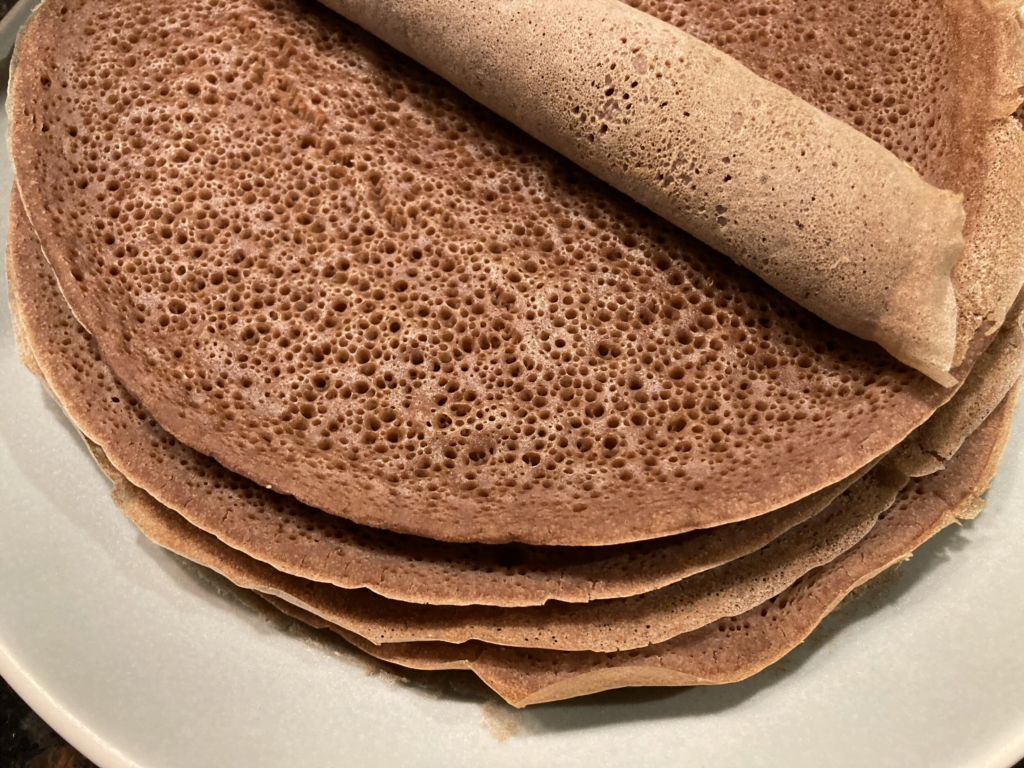
History and Background of Injera
- Injera is a traditional Ethiopian and Eritrean sourdough flatbread with a unique, slightly spongy texture.
- It’s a staple food in Ethiopian and Eritrean cuisines and is used as both a dish and a utensil: meals are often served on large pieces of injera, and additional rolled pieces of injera are used to pick up the food.
- Injera’s unique taste and texture result from fermentation, which gives it its tangy flavor.
- Teff flour, a grain native to the Horn of Africa, is the traditional primary ingredient. However, due to teff’s expense or availability issues outside East Africa, it can sometimes be mixed with other flours.
Ingredients for Injera
- 2 cups of teff flour (can be mixed with barley or wheat flour if teff is unavailable or expensive).
- 3 cups of water (adjust as needed).
- A pinch of salt.
- (Optional) 1/4 teaspoon of active dry yeast or baking soda (for quicker fermentation or added bubbles, respectively).
Recipe for Injera
Preparing the Batter
- In a large bowl, mix the teff flour and water together to create a batter with a smooth consistency, similar to pancake batter.
- Cover the bowl with a clean cloth or plastic wrap.
Fermentation
- Allow the batter to ferment at room temperature for 1-3 days. The time required will depend on the climate; warmer temperatures accelerate fermentation. The batter should bubble and develop a sour aroma when it’s ready.
- If you’re short on time or if the batter isn’t fermenting well, you can add a bit of active dry yeast to speed up the process. If you’re looking for added bubbles without the yeast, a bit of baking soda can be added just before cooking.
Cooking the Injera
- After fermentation, a layer of dark liquid might form on the top of the batter. This liquid, known as “eyes”, can be poured off or mixed back in, depending on personal preference.
- Stir in a pinch of salt.
- Heat a non-stick skillet or a special injera pan (called a “mitad”) over medium heat. No oil is required since injera typically isn’t browned like a pancake.
- Pour the batter in a spiral pattern, starting from the outside and working towards the center.
- Cover and cook for 2-3 minutes. The injera is ready when holes appear on the surface. Unlike pancakes, injera is only cooked on one side.
- Remove the injera and place it on a clean cloth to cool. Repeat the process with the remaining batter.
Serving
- Injera is traditionally served with a variety of stews, salads, and other dishes placed on top. Additional rolls of injera are provided for scooping up the food.
The flavor and texture of injera can vary based on the fermentation time and the specific types of flour used.
Adjustments might be needed based on how you enjoy the sourness and texture. If you’re new to making injera, it might take a few tries to get it just right.
Ethiopian Cuisine – Gomen

History and Background of Gomen
- Gomen is a traditional Ethiopian dish made primarily from collard greens. The term “gomen” is Amharic for collard greens.
- Vegetables play a crucial role in Ethiopian cuisine, particularly during fasting periods when meat and dairy are traditionally abstained from for religious reasons. The Ethiopian Orthodox Church observes several fasting periods throughout the year, and during these times, vegetable and legume dishes become staples.
- Gomen is often served alongside other dishes on the injera flatbread, providing a rich, flavorful green complement to spicy stews and other preparations.
Ingredients for Gomen
- 1-2 bunches of collard greens (can be substituted with kale), washed and chopped.
- 2 tablespoons of niter kibbeh (Ethiopian spiced butter) or regular butter.
- 1 large onion, finely chopped.
- 3-4 cloves of garlic, minced.
- 1-2 green chillies or jalapeños, deseeded and chopped (adjust according to heat preference).
- 1 inch of fresh ginger, grated or finely chopped.
- Salt to taste.
- (Optional) A pinch of turmeric for color.
- (Optional) A squeeze of lemon juice for added tang.
Recipe for Gomen
Preparing the Collard Greens
- Thoroughly wash the collard greens to remove any dirt or grit. Remove the tough stems and ribs.
- Chop the leaves into thin strips or small bite-sized pieces.
Cooking Process
- In a large pot or skillet, melt the niter kibbeh or butter over medium heat.
- Add the finely chopped onions to the pot and sauté until they’re translucent.
- Stir in the minced garlic, chopped chillies or jalapeños, and grated ginger. If you’re using turmeric, add it at this stage. Continue to sauté for an additional 2-3 minutes until the mixture is fragrant.
- Add the chopped collard greens to the pot. Stir well to ensure the greens are coated with the onion and spice mixture.
- Reduce the heat to low, cover the pot, and let the greens simmer until they are tender. This usually takes about 20-30 minutes, but the exact time can vary based on the freshness and variety of the greens.
- During the cooking process, the collard greens will release their moisture. However, if they seem too dry or start sticking to the pot, you can add a little water as needed.
- Once the greens are tender, season with salt and adjust any other seasonings as per your taste. If you’re using lemon juice, add it now and give everything a final stir.
Serving
- Gomen is best served warm. It can be enjoyed on its own, with rice, or traditionally, with injera. It pairs well with other Ethiopian dishes, especially meat and lentil stews.
Like many traditional recipes, Goman can be prepared with slight variations depending on regional and familial traditions.
Feel free to adjust ingredients and spices based on your preference.
Ethiopian Cuisine – Shiro

History and Background of Shiro
- Shiro is a popular and staple dish in both Ethiopian and Eritrean cuisines. It’s a thick stew made from powdered chickpeas or broad beans.
- Shiro often serves as a vital dish during fasting periods in the Ethiopian Orthodox Church when meat is abstained from. Due to its high protein content, it’s a filling and nutritious alternative.
- There are different variations of shiro based on the type of legume powder used, the spices mixed into the powder, and the additional ingredients in the stew.
- The dish is traditionally served atop injera, the sourdough flatbread, and is enjoyed by scooping it up with pieces of the bread.
Ingredients for Shiro
- 1 cup of shiro powder (chickpea or broad bean flour). This can sometimes be bought pre-seasoned.
- 2-3 tablespoons of berbere (Ethiopian spice blend). Adjust to taste and depending on the spiciness of the blend.
- 2-3 tablespoons of niter kibbeh (Ethiopian spiced butter) or regular butter or oil.
- 1 large onion, finely chopped.
- 3-4 cloves of garlic, minced.
- 1 tablespoon of finely chopped or grated ginger.
- 4-5 cups of water or vegetable broth (adjust based on desired consistency).
- Salt to taste.
- (Optional) 1-2 tomatoes, chopped.
- (Optional) 1 green bell pepper, chopped.
- (Optional) A pinch of ground cardamom and fenugreek.
Recipe for Shiro
Preparing the Base
- In a large pot, melt the niter kibbeh or heat the oil/butter over medium heat.
- Add the finely chopped onions and sauté until translucent.
- Stir in the minced garlic and ginger (as well as the chopped tomatoes and bell pepper if you’re using them) and continue sautéing until fragrant and the onions are golden brown.
Adding Spices
- Mix in the berbere spice, stirring continuously to ensure it doesn’t burn. Cook the mixture for 2-3 minutes.
- If you’re using additional spices like cardamom and fenugreek, add them now and give everything a good stir.
Making the Shiro Stew
- Gradually add water or vegetable broth to the pot, stirring continuously to ensure a smooth consistency.
- Bring the mixture to a boil.
- Once boiling, reduce the heat and start gradually whisking in the shiro powder, ensuring there are no lumps.
- Continue to cook the stew on low to medium heat, stirring regularly to prevent sticking. As it cooks, the shiro will thicken.
- Let it simmer for about 15-20 minutes. If the stew becomes too thick, you can add more water or broth to reach your preferred consistency.
Seasoning
- Season with salt to taste. Adjust other seasonings if necessary.
Serving
- Serve the shiro hot, traditionally poured over injera. Additional rolls of injera or bread can be provided on the side for scooping up the shiro.
- Shiro is often garnished with a drizzle of niter kibbeh or a sprinkle of berbere on top before serving.
Shiro is a versatile dish, and there are many regional and familial variations. The type of shiro powder (whether it’s made from chickpeas or broad beans, and whether it’s pre-seasoned or plain) will influence the dish’s final taste.
Adjust spices and ingredients based on your preferences and the kind of shiro powder you’re using.
Ethiopian Cuisine – Misir Wat

History and Background of Misir Wat
- Misir Wat, also known as Mesir Wat, is a spicy red lentil stew and a staple dish in Ethiopian cuisine.
- Lentils are a significant source of protein and nutrients in Ethiopian dietary habits, especially during the fasting seasons of the Ethiopian Orthodox Church when meat and dairy are abstained from.
- The dish is characterized by its rich flavor, resulting from the combination of red lentils and the spicy Ethiopian berbere seasoning.
- Misir Wat is traditionally served with injera, the sourdough flatbread that is a staple in Ethiopian meals.
Ingredients for Misir Wat
- 1 cup of red lentils, washed and drained.
- 2-3 tablespoons of berbere spice mix (adjust to taste).
- 1 large onion, finely chopped.
- 2-4 cloves of garlic, minced.
- 1 tablespoon of grated or finely chopped ginger.
- 3 tablespoons of niter kibbeh (Ethiopian spiced butter) or regular butter or vegetable oil.
- 2-3 cups of water or vegetable broth.
- 1-2 tomatoes, finely chopped (optional but recommended).
- Salt to taste.
- (Optional) 1 green bell pepper, finely chopped.
- (Optional) A pinch of ground cardamom or “korerima” (Ethiopian cardamom).
Recipe for Misir Wat
Preparation
- Begin by washing the red lentils thoroughly in cold water until the water runs clear. This helps remove any impurities and excess starch. Drain them and set aside.
Cooking the Onions and Spices
- In a large pot, melt the niter kibbeh or heat the vegetable oil/butter over medium heat.
- Add the finely chopped onions and sauté until they turn translucent.
- Incorporate the minced garlic and ginger, continuing to sauté until the mixture is fragrant.
- Stir in the berbere spice mix (and cardamom if you’re using it), ensuring it’s well combined with the onions, garlic, and ginger.
Adding Lentils and Tomatoes
- Add the washed red lentils to the pot, stirring them into the onion and spice mixture until they’re well coated.
- If you’re using tomatoes, add them now and mix until everything is combined.
Simmering the Stew
- Pour in the water or vegetable broth, ensuring it covers the lentils. Depending on the desired consistency, you can adjust the amount of liquid. Misir Wat is typically a thick stew.
- Bring the mixture to a boil, then reduce the heat to low, allowing it to simmer gently. As the lentils cook, they’ll soften and break down, thickening the stew.
- Let it simmer for about 20-30 minutes or until the lentils are fully cooked and have absorbed most of the liquid. Stir occasionally to prevent sticking.
- If you’re using green bell pepper, you can stir it in during the last 10 minutes of cooking.
Final Seasoning
- Season with salt to taste and adjust other seasonings if necessary.
Serving
- Misir Wat is best served hot, poured over injera. Often, it’s accompanied by other Ethiopian dishes, allowing for a variety of flavors in one meal. A fresh salad or some sautéed greens would complement it nicely.
The richness and heat level of Misir Wat can vary based on the berbere’s potency. Adjust the amount of spice mix to your preference.
As with many traditional recipes, variations exist depending on regional and familial traditions, so feel free to tweak the recipe to suit your taste.
Ethiopian Cuisine – Doro Wat
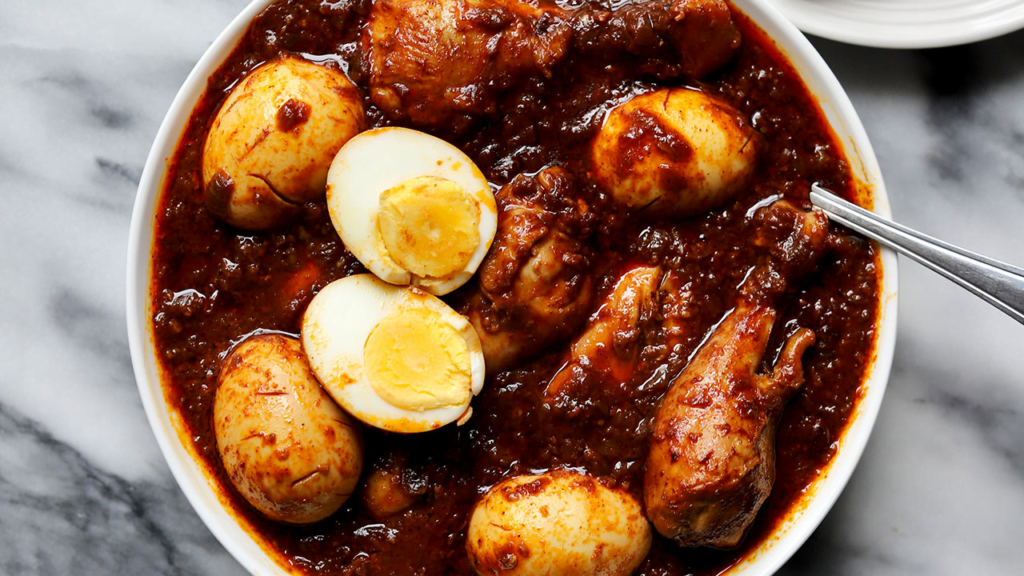
History and Background of Doro Wat
- Doro Wat, often simply referred to as “Wat”, is a spicy chicken stew that is one of the most famous dishes in Ethiopian cuisine.
- The term “Doro” means “chicken” in Amharic, and “Wat” refers to “stew”.
- This rich and flavorful stew is traditionally served during special occasions, including holidays and festivals.
- Doro Wat is often paired with injera, the Ethiopian sourdough flatbread, which is used to scoop up the stew.
- The dish is characterized by its deep red color, achieved from the use of berbere spice and slow cooking.
Ingredients for Doro Wat
- 2-3 pounds of chicken pieces (traditionally, drumsticks and thighs are used).
- 2-3 tablespoons of berbere spice mix (adjust to taste).
- 2 large onions, finely chopped or blended to a puree.
- 3-5 cloves of garlic, minced.
- 1 tablespoon of ginger, grated or finely chopped.
- 4 tablespoons of niter kibbeh (Ethiopian spiced butter) or regular butter.
- 2 cups of water or chicken broth.
- 2 tablespoons of tomato paste (optional).
- 2-3 hard-boiled eggs (shell removed).
- Salt and pepper to taste.
- Juice of 1 lemon.
- (Optional) A pinch of ground cardamom or “korerima” (Ethiopian cardamom).
- (Optional) A sprig of fresh thyme or a pinch of dried thyme.
Recipe for Doro Wat
Chicken Preparation
- Clean the chicken pieces, removing any excess fat. Marinate them in lemon juice and a bit of salt for about 30 minutes.
- After marinating, rinse the chicken to remove the lemon juice and salt, then pat dry. Set aside.
Making the Onion Base
- In a large pot or Dutch oven, melt the niter kibbeh or butter over medium heat.
- Add the finely chopped onions (or onion puree) and cook until they are translucent and soft, without letting them brown. This can take about 20 minutes.
- Stir in the minced garlic and ginger, and cook for another 5-7 minutes until fragrant.
Adding Spices and Chicken
- Mix in the berbere spice, tomato paste (if using), and a bit of salt and pepper. Continue to sauté for another 5 minutes, allowing the spices to meld with the onions.
- Add the chicken pieces to the pot, ensuring each piece is well coated with the onion and spice mixture.
Simmering the Stew
- Gradually pour in the water or chicken broth, ensuring the chicken pieces are almost submerged.
- Bring the stew to a gentle boil, then reduce the heat to low, covering the pot. Let it simmer slowly for about 45 minutes to an hour, stirring occasionally. The slow cooking allows the chicken to become tender and the flavors to intensify.
- If using cardamom or thyme, you can add it midway through the simmering process.
Adding Hard-Boiled Eggs
- About 10 minutes before the stew is done, gently place the hard-boiled eggs into the stew, allowing them to warm up and absorb some of the flavors.
Final Adjustments
- Check the seasoning, adjusting the salt, pepper, or other spices if necessary. The stew should be thick, with a deep red color and the chicken pieces tender.
Serving
- Serve the Doro Wat hot, traditionally ladled over injera. The hard-boiled eggs are typically cut into halves or quarters and placed atop the stew.
The spice level of Doro Wat can be adjusted by increasing or reducing the amount of berbere spice mix.
The dish’s richness and heat are its signatures, so feel free to tweak based on your preference. Remember, like all traditional recipes, there are variations depending on regional and familial traditions.
Adjust ingredients and methods to suit your taste.
Ethiopian Cuisine – Tibs
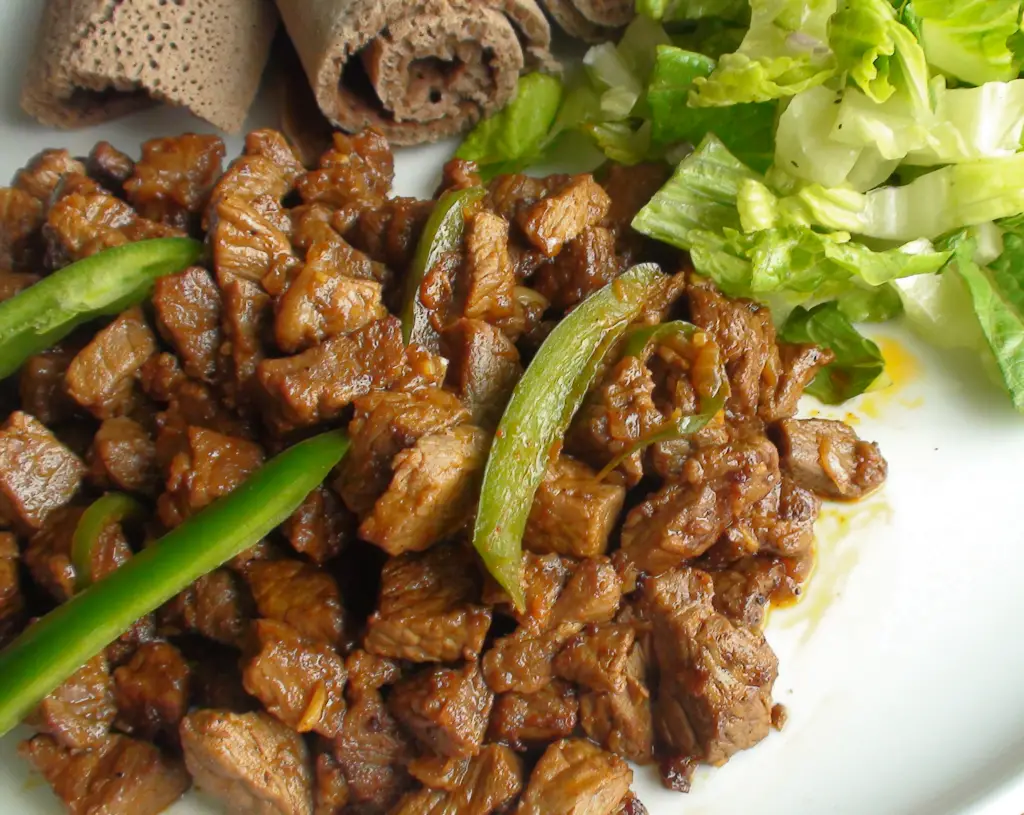
History and Background of Tibs
- Tibs is a traditional Ethiopian dish, typically made from sautéed or grilled meat, usually lamb or beef.
- The term “Tibs” translates to “slices” or “pieces” in Amharic, which aptly describes the dish’s primary feature: bite-sized pieces of meat.
- It is often eaten to commemorate special occasions and holidays.
- Tibs can be prepared in various ways – it might be spicy or mild, and sometimes vegetables are added.
- It’s commonly served with injera or awaze (a type of spicy dip), but it can also be eaten with rice or bread in more modern adaptations.
Ingredients for Tibs
- 1-1.5 pounds of beef or lamb, cut into bite-sized pieces (tender cuts like sirloin or tenderloin are preferred).
- 2-3 tablespoons of niter kibbeh (Ethiopian spiced butter) or vegetable oil.
- 2 large onions, thinly sliced.
- 2-4 cloves of garlic, minced.
- 1 tablespoon of ginger, grated or finely chopped.
- 1-2 green bell peppers, deseeded and sliced.
- 1-2 chili peppers (like jalapeño), deseeded and sliced (adjust based on heat preference).
- 1-2 teaspoons of berbere spice (optional for added heat and flavor).
- Salt and pepper to taste.
- (Optional) A sprig of rosemary or thyme.
- (Optional) Fresh tomatoes, sliced.
Comprehensive Recipe for Tibs
Preparing the Meat
- Begin by cleaning the meat, removing any excess fat or sinew. Pat dry using a paper towel. Cut it into bite-sized pieces or strips.
Sautéing Onions and Spices
- In a large skillet or pan, heat the niter kibbeh or vegetable oil over medium heat.
- Add the thinly sliced onions, sautéing them until they become translucent and tender.
- Stir in the minced garlic and ginger, cooking until fragrant, which is usually about 2-3 minutes.
Cooking the Meat
- Increase the heat to medium-high. Add the meat pieces to the skillet or pan, ensuring they are evenly spread out. Season with salt and pepper.
- Allow the meat to sear, turning occasionally, until browned on all sides.
- If using berbere spice, sprinkle it over the meat and mix well, ensuring the meat pieces are coated.
Adding Vegetables
- Reduce the heat to medium. Introduce the sliced bell peppers, chili peppers, and optional tomatoes to the pan. Stir well to combine.
- If you’re using rosemary or thyme, add it now.
- Continue to cook, stirring occasionally, until the vegetables are tender and the meat is fully cooked – approximately 10-15 minutes.
Final Adjustments
- Taste and adjust the seasoning if needed. The dish should have a balanced flavor with the natural taste of the meat enhanced by the spices and vegetables.
Serving
- Tibs is best served hot, straight from the pan. Traditionally, it’s laid atop injera with sides like salads or lentil dishes. Some also enjoy it with a side of awaze for added flavor.
Tibs is a versatile dish, and the recipe can be adapted based on personal preferences. Some might prefer a spicier version with more chilis or berbere, while others might opt for a milder flavor.
The type of meat, its cut, and its quality will also influence the final dish. Always choose fresh, high-quality meat for the best results.
Ethiopian Cuisine – Kitfo
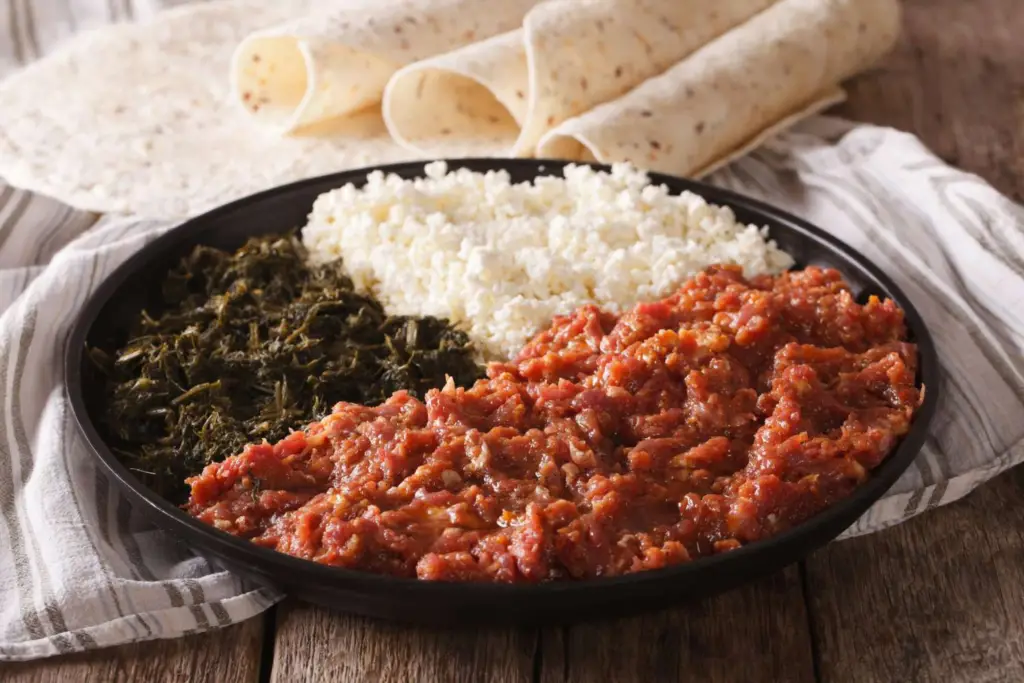
History and Background of Kitfo
- Kitfo is a traditional Ethiopian dish primarily made from raw minced beef, seasoned with various spices and herbs.
- The name “Kitfo” is derived from the Ethiopian word “Kətfä”, which means “to chop” or “to mince”.
- It has roots in the Gurage culture, one of the ethnic groups in Ethiopia.
- Consumed primarily during special occasions, holidays, or festivities, Kitfo is often reserved for high celebrations or gatherings.
- The dish’s key ingredient is “mitmita”, a fiery spice blend, and it’s customarily served with a special butter known as “niter kibbeh”.
- While Kitfo is traditionally consumed raw, variations exist where the meat is lightly cooked (lebleb) for those hesitant to eat it fully raw.
Ingredients for Kitfo
- 1 pound of very fresh beef (preferably lean cuts like tenderloin), minced or finely chopped.
- 3-4 tablespoons of niter kibbeh (Ethiopian spiced clarified butter).
- 1-2 tablespoons of mitmita (Ethiopian chili spice blend) or to taste.
- Salt to taste.
- (Optional) Cardamom or “korerima” (Ethiopian cardamom), ground.
- Freshly chopped collard greens or spinach for a side dish.
- Fresh cheese (like Ethiopian ayib) or cottage cheese for serving.
- Injera (Ethiopian sourdough flatbread) for serving.
Recipe for Kitfo
Preparation of the Meat
- Begin by ensuring that the beef is extremely fresh since the dish is traditionally consumed raw.
- Clean the beef and remove any excess fat or sinews.
- Finely chop or mince the beef using a sharp knife or food processor. Some prefer to have it ground twice to ensure a very fine consistency.
Seasoning the Meat
- In a mixing bowl, combine the minced beef, mitmita, salt, and optionally, a touch of ground cardamom or korerima. Mix well to ensure even distribution of spices.
- Melt the niter kibbeh until it’s in liquid form. Add it to the beef mixture. Mix again until everything is well combined and the beef has taken on a slightly orange hue from the spices and butter.
Serving
- If consuming raw: Serve immediately after mixing with the spices.
- If you prefer it slightly cooked (lebleb): In a skillet, heat a little bit of niter kibbeh and quickly sauté the kitfo just until it’s lightly browned but still very rare inside.
- Traditionally, kitfo is served with injera on the side, along with collard greens or spinach and fresh cheese like ayib or cottage cheese.
- The greens can be sautéed lightly in niter kibbeh with some garlic for added flavor.
Kitfo is a dish that truly celebrates the raw essence of the meat, enhanced by the robust flavors of Ethiopian spices. However, consuming raw meat does come with risks, including potential exposure to harmful bacteria.
Always ensure that you source the freshest possible beef from trusted butchers or suppliers and maintain strict hygiene during preparation.
For those who are wary of raw meat, the lightly cooked version offers a safer yet still traditional and flavorful option.
Conclusion
As I conclude this journey of discovering Ethiopian cuisine and recipes, I am left with a newfound appreciation for the flavors and traditions of this vibrant culinary culture.
From the diverse range of spices to the unique cooking techniques, Ethiopian cuisine offers a truly unique culinary experience that is both delicious and culturally significant. Whether you are a meat-lover or prefer plant-based options, there is something for everyone in Ethiopian cooking.
Exploring traditional Ethiopian dishes, mastering vegetarian recipes, understanding the significance of injera, and experiencing the coffee ceremony are just some of the highlights of this culinary journey. And with the step-by-step instructions provided, bringing Ethiopian flavors to your own kitchen is easier than you might think!
So don’t hesitate to embark on your own Ethiopian culinary adventure today. Start by trying out some traditional dishes or experimenting with spices and flavors in your cooking. You won’t be disappointed!
FAQ’s
What is Ethiopian cuisine known for?
Ethiopian cuisine is known for its unique flavors, diverse spices, and traditional dishes that reflect the country’s rich cultural heritage.
What are the key elements of Ethiopian cuisine?
Ethiopian cuisine is defined by its variety of spices, distinct cooking techniques, and the use of injera, a sourdough flatbread.
What are some traditional Ethiopian dishes?
Traditional Ethiopian dishes include Doro Wat (spicy chicken stew), Tibs (grilled meat), and Kitfo (minced raw meat).
What are some popular Ethiopian spices?
Berbere and mitmita are two popular Ethiopian spice blends that add unique and aromatic flavors to Ethiopian dishes.
Are there vegetarian options in Ethiopian cuisine?
Yes, Ethiopian cuisine offers a wide range of delicious vegetarian dishes, including spicy lentil stews and flavorful vegetable curries.
What is injera and why is it significant?
Injera is a sourdough flatbread that is a staple in Ethiopian cuisine. It is significant because it serves as both a utensil and a base for other dishes.
What is the Ethiopian coffee ceremony?
The Ethiopian coffee ceremony is a traditional cultural event where coffee is prepared and served with rituals and traditions that date back centuries.
What are some Ethiopian culinary traditions?
Ethiopian culinary traditions include communal dining, sharing food from a common plate, and the significance of certain dishes in celebrations and gatherings.
How can I bring Ethiopian flavors to my kitchen?
You can bring Ethiopian flavors to your kitchen by following authentic Ethiopian recipes and experimenting with traditional spices and ingredients.
This article was last edited on

